Home
3A Gallery has relocated to 179 Canal Street, #5A, New York, NY 10013
Asad Raza: Ge is for Gaia
January 26 – March 2, 2024, Opening hours: Thursday to Saturday, 2-6pm
Opening reception: Friday January 26, 6-8pm
https://en.wikipedia.org/wiki/Asad_Raza_(artist)
Asad Raza: Ge is for Gaia
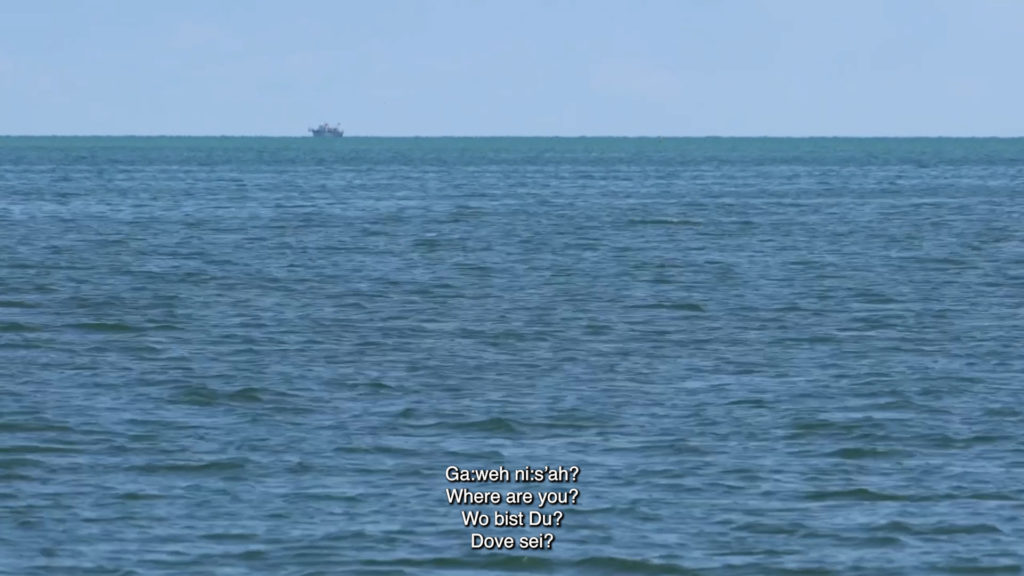


3A Gallery presents the first New York exhibition of Asad Raza’s Ge, an endless and evolving video narrative that blends fiction and documentary as it moves around the planet. First commissioned in 2020 by the Serpentine Galleries’ General Ecology program, the video serves as a dynamic container for Raza’s wide-ranging thinking, research, and writing around ecology. Named after the original name of the goddess of Earth, Gaia, Ge juxtaposes multiple thematic sections, which change with each release of the video. Audio description and subtitles form an integral part as the work plays with the distinction between “description” and “content”, underscored by the repetition of specific sections with different narration and captioning.
In its most recent release, the piece consists of four “stanzas.” The first explores the bioscape around the Dorset home of James Lovelock, originator of the Gaia hypothesis, which provoked a major increase in ecological consciousness in the last thirty years. This visual portrait immerses the viewer in the originary context for the idea of the planet as a living feedback loop. The second stanza features the artist and his infant daughter demonstrating how to make fertile soil out of common materials. The third captures an arduous, three-day sailing trip with seven musicians across Lake Erie, set to an electronic composition with verses in the Seneca language. The fourth stanza was shot at the ruined convent where Hildegard von Bingen had visions, and features a reading of a famous passage by Hildegard, translated into Arabic and read by writer Lama El Khatib.
Asad Raza’s polymathic practice represents an expanded approach to artmaking—encompassing installations, writing, curating, dramaturgy, filmmaking, pedagogy, and organizing. It often takes local ecosystems and planetary ecologies as a focus. Across his work, there is a strong emphasis on the participatory and the performative aspects of art, as well as an engagement with all of the human senses. His recent exhibitions and ambitious public art projects, such as Diversion (2022, Kunsthalle Portikus, Frankfurt), Absorption (2019–, Kaldor Public Art Projects, Sydney; Gropius Bau, Berlin; Ruhrtrienniale, Essen; CCA Glasgow; Museion, Bolzano), and Root sequence. Mother tongue (2017 Whitney Biennial, New York; Rockbund Museum, Shanghai; Sifang Museum, Nanjing; TU Gallery, Dresden), all involve both scripted and improvised interactions with natural materials. This entanglement between humans and their environments is at the core of his approach.
Raza’s work is also intrinsically collaborative, emerging out of multipart interdisciplinary dialogues. For example, each iteration of Absorption involves work with experts including soil scientists, horticulturalists, compost specialists, and organic farmers. Orientation, developed for FRONT International 2022, emerged out of dialogues with astronomers, physicists, architects, and musicians. In Raza’s practice, the artist is a director, a convener, a gatherer of beings who frames unexpected conversations between humans and more-than-humans alike. This porosity—suggesting new roles for the artist in society—is an important rejoinder to the limited, object and market-driven conception of contemporary art.
—Prem Krishnamurthy
Asad Raza
Ge, 2020-ongoing
digital video, sound, audio description, subtitles
Locations to date: Dorset, England; Berlin, Germany; Lake Erie, USA; Disibodenberg, Germany
Producers: Olivia Fairweather, Bronwyn Keenan, Marissa Leitman, Holly Shuttleworth,
Camera: Will Hazell, Marianna Simnett, Haniff Clarke, Andrea Mancuso, Rafay Rashid
Sound designer: Ruth Knight
Sound recordist: Ben Gandy, RA Washington
Music: Asad Raza, RA Washington
Camera assistants: Simone Picknett, Anna von Raison
Editing: Laura Fong Prosper, Anja Zhukova
Musicians: RA Washington, LaToya Kent, Rafay Rashid, Shasti O’Leary Soudant, Olivier Delrieu-Schwartz, Andrea Mancuso
Color: Sergej Jurisdizkij
Special Thanks: Shane Anderson, Shumon Basar, Descha Daemgen, Louise Höjer, Kathrin Jira, Alex McBratney, Hana Miletic, Hans Ulrich Obrist, Lucia Pietroiusti, Filipa Ramos, Kostas Stasinopoulos, Christopher Wierling, Vasilis Zarifopoulos, Mathias Zeiske





Stills from Ge, Asad Raza, 2020-ongoing
Press: https://www.moussemagazine.it/magazine/asad-raza-3a-gallery-new-york-2024/
Dan Graham – Dan Graham’s Schema, 1966 – 1975, Curated by Jennifer Buonocore-Nedrelow
March 25 – May 6, 2023, Opening reception is Saturday, March 25, 6-8 pm.
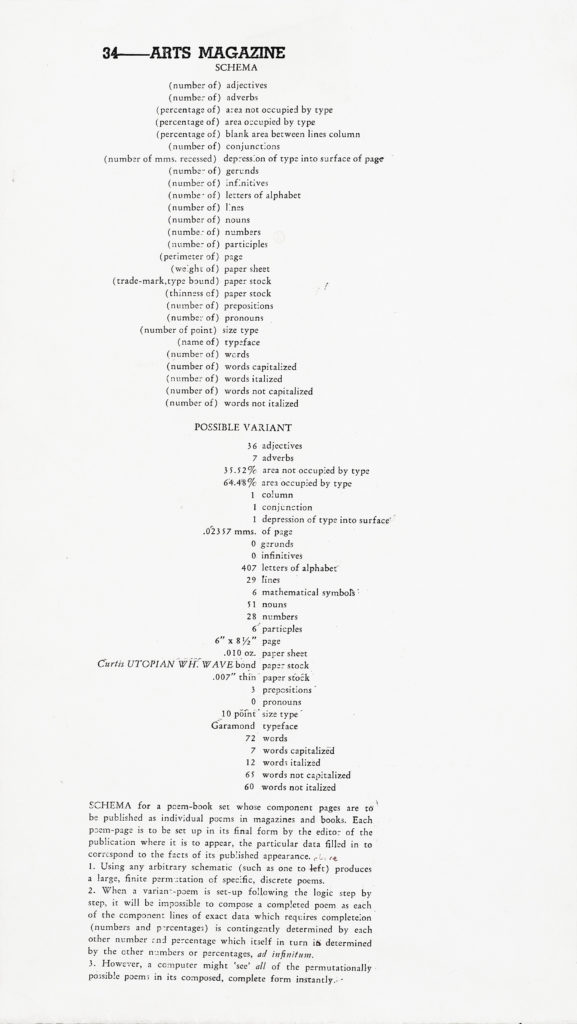
Dan Graham’s Schema (March 1966), 1966–1975
For Dan Graham, Schema (March 1966) (1966–) was a breakthrough. As he would reflect in 2012: “An exemplary and perhaps the most absolute complex, proto-conceptual magazine page that I made is Schema (March 1966).” Part of a series of democratic “magazine works” (others include “Homes for America,” Scheme, and Figurative), Schema is proposal for an open set of variable and site-specific poetry. It is an exhaustively self-referential model designed to produce “a very large, though finite permutation of specific, discrete, possible poems.” In order to create a poem-variant, any editor can use Schema’s instructional inventory that quantifies and determines all possible aspects of that specific poem-variant’s form and content (elements of grammar, parts of speech, typographic style, and design). In Graham’s words, Schema “takes its own measure—of itself as place, that is placed two-dimensionally on (as) a page.”It must be read in the context of publications.
More than simply an unorthodox poem or work of conceptual art, Schema, deceptively simple, strange, and whimsical, does not conform to any established genre or art form. Inspired by installation instructions that Graham sent to the collector Herman Daled in the 1970s, this exhibition brings together an early description of Schema from Graham’s archives, page proofs of an unpublished variant initially created for Arts Magazine and later gifted to Sol LeWitt, and nearly all the poem-variants printed through 1975 in their original contexts—books and magazines. “The context is very important. I wanted my work to be about place as in-formation,” Graham later said. I pitched this show to Dan when he was alive. He liked the idea.
The opportunity to view Schema as a collection reveals the significant role played by each publication and its readership in the production of its meaning. In 1967, it was printed for the first time in an issue of the experimental multimedia magazine Aspen edited by Brian O’Doherty (also known as Patrick Ireland). In the pages of that same issue, Roland Barthes posited “The Death of the Author” in his landmark essay that articulated a shift in authorial authority from writer to reader and extrapolated its consequence: “every text is eternally written here and now.” As a proposal for a set of user-generated poems, Schema embodied this idea. Despite Graham’s suggestion that “it would be possible to ‘compose’ the entire set of permutationally possible poems and to select the applicable variant(s) with the aid of a computer,” human editors manually produced all the poem-variants on view. Schema is written in pseudocode, a subjective notation resembling a simplified programming language that cannot be read by a computer.
While Graham initially thought of Schema as a permutational poem, it marked the emergence of conceptual art in New York. In December 1966, Graham contributed “Plan for Poem,” an early version of Schema, to the protoconceptual exhibition Working Drawings and Other Visible Things on Paper Not Necessarily Meant to Be Viewed as Art. In 1969, Schema and a new poem-variant were printed in the first issue of Art-Language, the journal of the British collective Art & Language, alongside Sol LeWitt’s “Sentences on Conceptual Art” and Lawrence Weiner’s “Statements.” Other variants followed in the experimental literary magazine Extensions (inspired by Marshall McLuhan’s writings), Konzeption/Conception (Rolf Wedewer’s early survey of conceptual practices), and art and poetry anthologies (Richard Kostelanetz’s Possibilities of Poetry and Ursula Meyer’s Conceptual Art).
When Graham began work on Schema, he primarily thought of himself as a writer. And writing provided him with the opportunity to reframe Schema into the following decade. In the 1970s, Schema achieved a new level of self-reflexivity as Graham began collecting and republishing previously published poem-variants—reproductions of reproductions—in artists’ magazines and books. In the critical essays “The Artist as Bookmaker: The Book as Object” and “Information,” he pointed to diverse forebearers: Jorge Luis Borges, Marcel Duchamp, Dan Flavin, Kurt Gödel, Donald Judd, Sol LeWitt, Stéphane Mallarmé, Marshall McLuhan, Roy Lichtenstein, and thirteenth-century poet-mystic Ramon Llull. In 1975, he collected additional “observations,” “implications,” and “afterthoughts” in For Publication (1975), the last publication in this show.
The exhibition opens with one of Graham’s first interactive works of art, One (c. 1966). Like his “magazine works,” Graham modeled One after a popular, mass-produced good, the 15 puzzle that features sliding numbered square tiles.He also originally exhibited it as a poem. All the tiles are equal. There is no objective to this game. As Lucy Lippard observed in “The Dematerialization of Art” (1968), the essay that anticipated her later book of the same name, “all the possible permutations are equally acceptable within the ratio one-as-one-as-one-as-one.” Holding One in their hands like a book, reader-viewers can shift the tiles around—generating new (but equivalent) poems with each move.
Dan Graham’s “Schema,” 1966–1975, is part of a series of exhibitions in New York intended to honor Graham’s life and work. I spent a lot of time talking with Dan at a mustard-yellow kitchen table designed by Mieko Meguro Graham. The table in this exhibition, designed by my brother John Buonocore, is painted the same color.
Jennifer Buonocore-Nedrelow
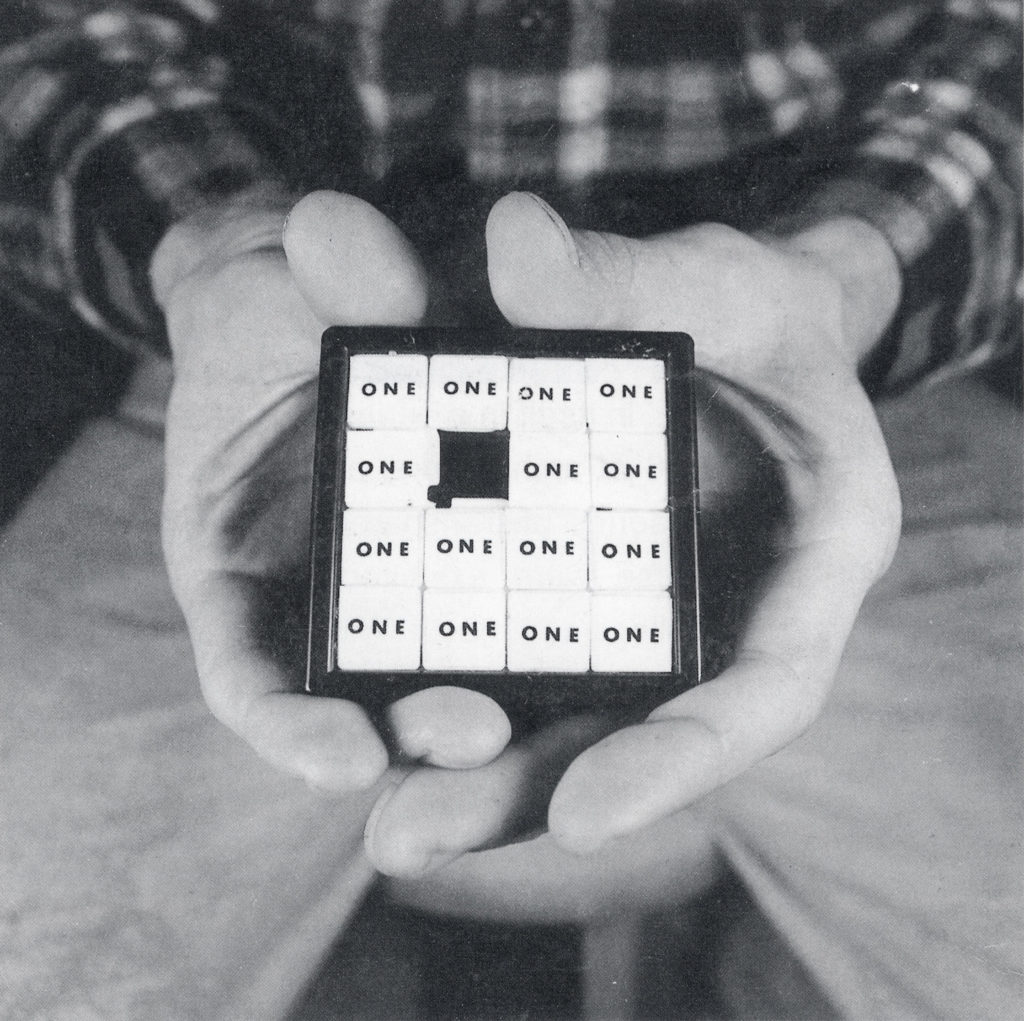












Installation photographs by Scott Nedrelow.
Sophie Kitching, “Nocturne”. January 7 – February 18, 2023
Opening reception: 6 -8 pm, January 7th, 2023
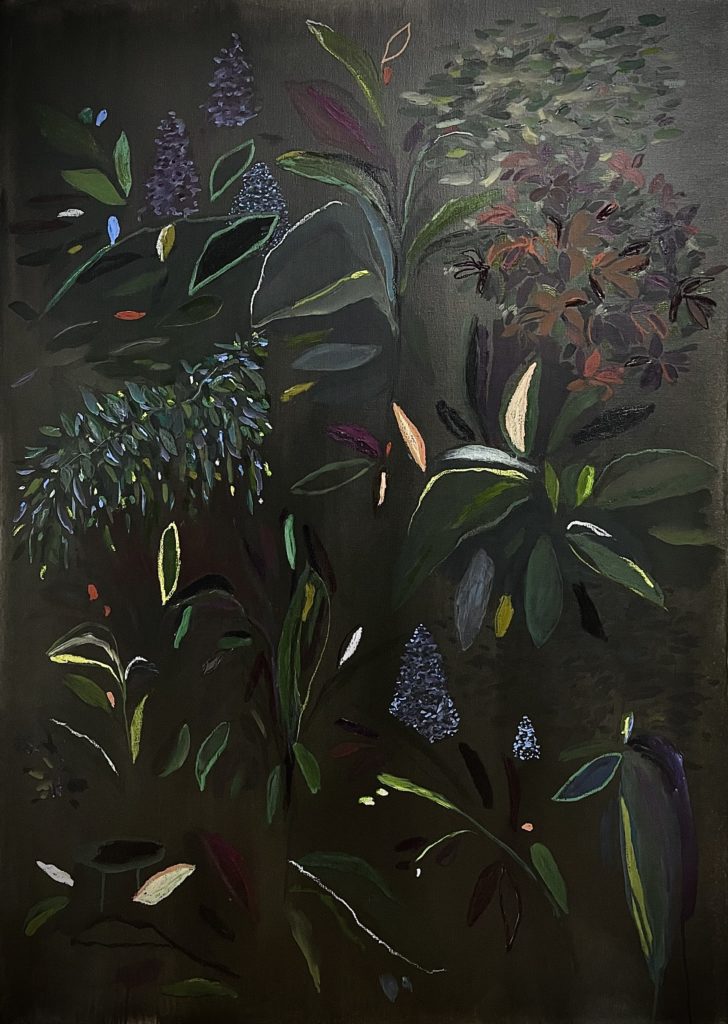
ink, oil, watercolor, charcoal, pastel on canvas
56 x 40 inches (142 x 101 cm)
In Sophie Kitching’s “Nocturne”, which sonata can you hear? Chopin?My favorite nocturne is Beethoven’s Piano Sonata No. 14, Moonlight Sonata.
Speaking of Beethoven, I once had an argument with Dan Graham. Dan saw Beethoven as a heartbroken and deaf loser. I said no, Beethoven had a sweet tooth and in his time sugar contained zinc. Therefore, he lost his hearing from over consumption of this mineral and not from a broken heart. And listen! In Beethoven’s Symphony No. 5, fate knocks on the door. Who realizes fate is knocking on your door? In my opinion, he was a positive thinking person. Furthermore, Symphony No. 9 is a good example of the composer’s positivity. It’s full of joy. So, Beethoven is no loser. Then Dan smiled amusingly and made no reply.But when I think about it now, perhaps Dan was thinking about Piano Sonata No. 14, Moonlight Sonata, or Piano Sonata No. 8, Sonata Pathétique, or something, when he said that.
Sophie’s “Nocturne” is dark, but has so many colorful flowers that are scattered and shining. Now, if Dan were here with me and we could look at Sophie Kitching, “Nocturne” together, what would he say? We might talk about Debussy’s Clair De Lune.
– Mieko Meguro
Nocturne
Dark petals
Anguish leaves
Flowing and falling
Frozen in place
A drawing an image a vision
What are we seeing
A portrait of a painting
Unveiling through the night
Where everything feels possible
Awaken dreams and musical loops
Sleep working over the bridge
For a while, stretched in space,
A score of touches and tones
On an empty ground, of light.
There is a stillness
An enveloping silence and bliss
Like a companion
A trace drifting on a page
Color schemes,
Overlapping seams
A surface to wander upon
In a room of one’s own.
Nocturnal beings adrift
Suspended in time
A diagonal line,
A zone of density,
To fill one’s memory
With invisible scenes
Dim-lit flora
Undiscerning vegetal
As one’s eye travels
As far as the mind can see
Spare a few moments
To swivel, and oscillate,
In this obscured landscape
For the first time, again.
-Sophie Kitching
Sophie Kitching’s Nocturne series are a nod to the musical compositions of the XIXth century. Rather than a night view of her brighter works on white canvas, these new paintings act as their functional negative, delving deeper into the representation of light and shadow using black ink mixed with neutral tones and Payne’s grey as a backdrop, and allowing for intricate games of push & pull to unfold on the surface. Fragments of abstracted nature emerge in relation to memories of lived environments. Kitching mixes oil, watercolor, charcoal, and pastel, choosing earthy shades, dark hues, and invisible green, which she enhances with notes of bluish turquoise, venetian red, and bright yellow. These paintings evoke recognizable scenes where each element gradually fades to reveal a telling portrait of a vision, and at once a subtle cue to the artist’s process.
Sophie Kitching (b. 1990, Isle of Wight, UK) lives and works in New York. She graduated from the École nationale supérieure des Arts Décoratifs, Paris and was awarded an international grant to study at the School of Visual Arts, New York. Kitching works in various media, including installation, painting, and sculpture. With a poetic exploration of her surroundings and natural phenomena, her works offer in-depth reflections on the concepts of spaces and realities, through an alluring materiality. In her exhibitions, the artist creates atmospheres of both utopic otherworldliness and a grounded familiarity for the viewer to enter.
Recent exhibitions include “De Leur Temps VII” (2023), at Frac Grand Large – Hauts de France, Dunkirk; “touch of time” (2022) at Alice Folker Gallery, Copenhagen; “Degrees, Minutes & Seconds” (2022) at The Finch Project, London; “Enter Art Fair” (2022) with Alice Folker Gallery, Copenhagen; “Maison 1729” (2022) in collaboration with House of Ruinart during Frieze Art Fair, New York; “The English Garden” (2022) at Galerie Isabelle Gounod, Paris; “i set my face to the hillside” (2022) at PS122 Gallery, New York; “carte blanche” (2021) at Park Hyatt, New York; “ATLAS” (2021) at 187 Lafayette St, New York; “Window Series” (2019) at Kiosk in Le Corbusier’s Cité Radieuse, Marseille; “Invisible Green (2019) at Galerie Vaste Horizon, Arles; “Nuits Américaines” (2017-2018) at Maison de Chateaubriand, Châtenay-Malabry; “Appareiller” (2017) at Palais de Tokyo, Paris. In 2016, Sophie Kitching was nominated for the “Bourse Révélations Emerige”; in 2017 her first monographic catalogue was published by Lienart and she created sets for the Ballet “Don Quichotte” at the Opéra national du Capitole in Toulouse. In 2018-2022, she was awarded a Studio Residency as part of Painting Space 122 in New York.

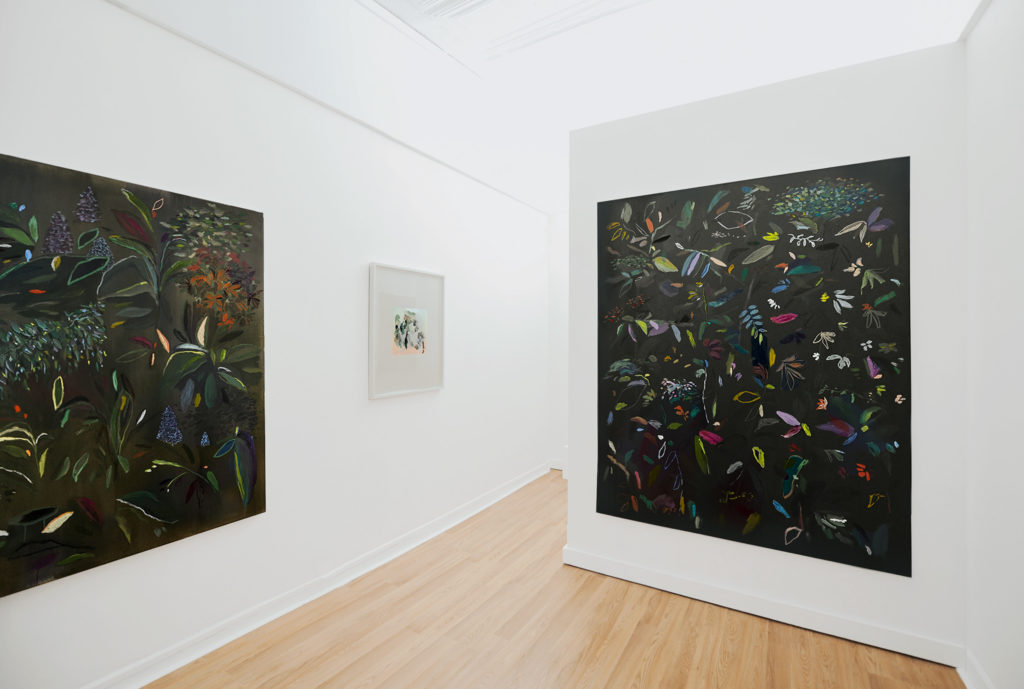

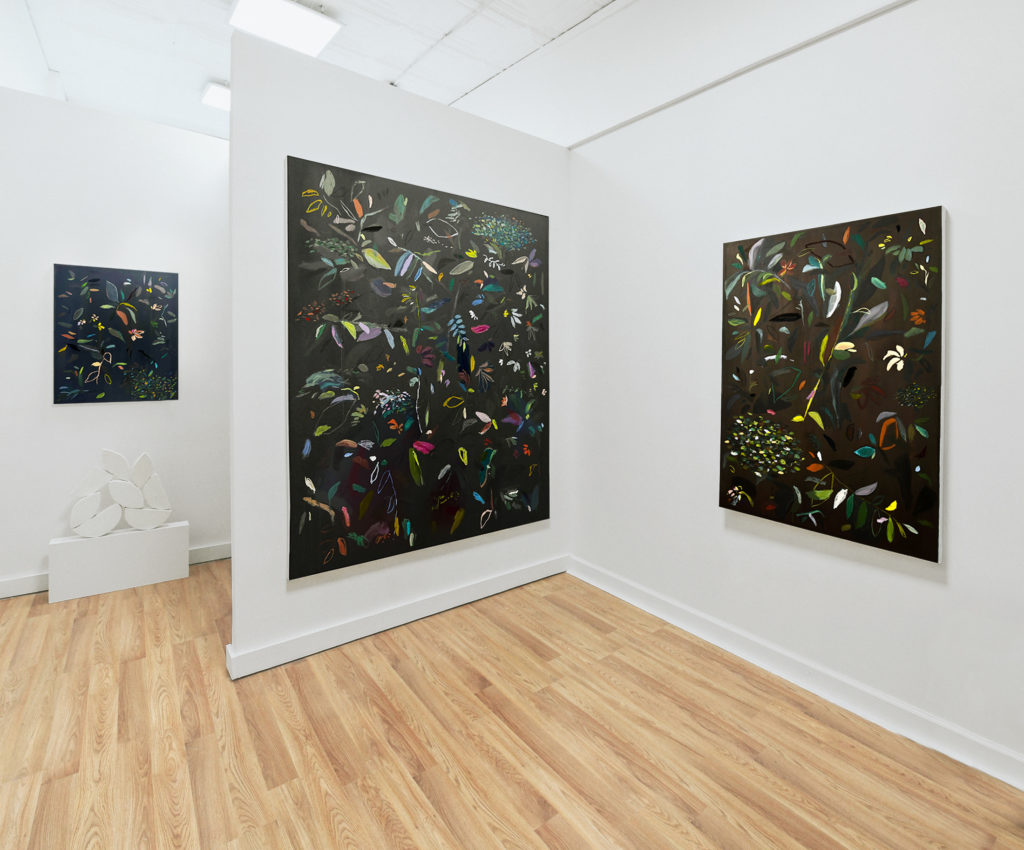





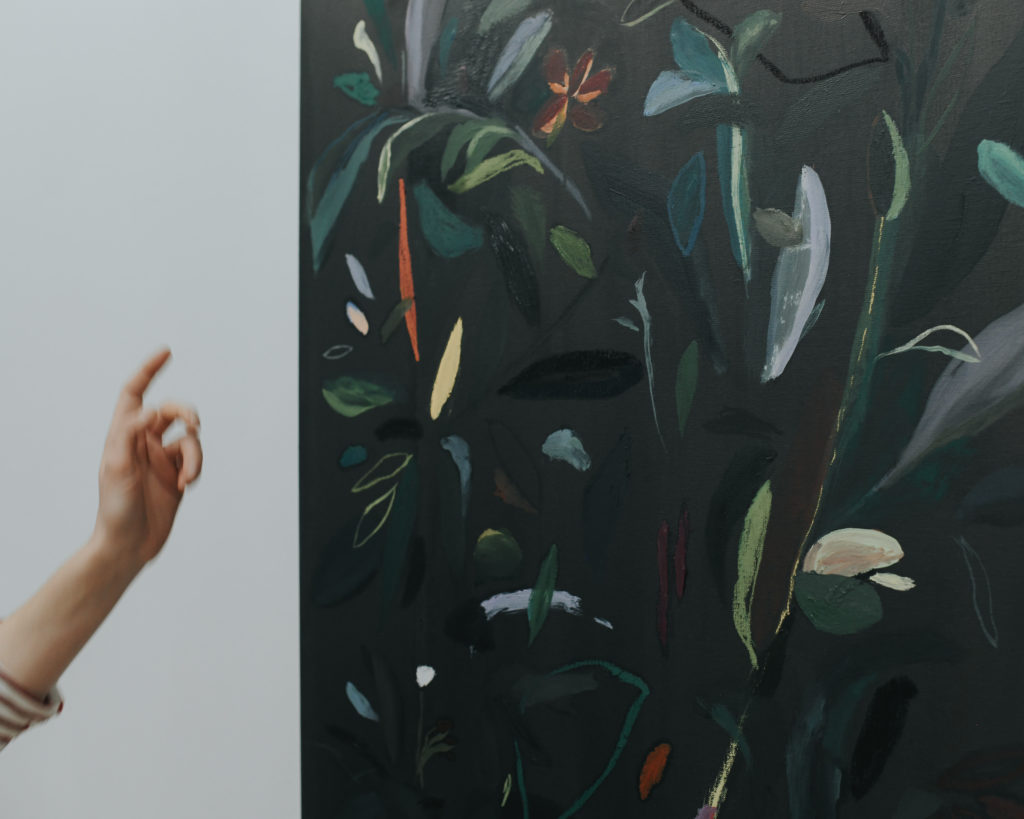
Satoru Eguchi. June 5–July 17, 2022.
Gallery hours: Sunday 2PM–6PM and by appointment. Please make an appointment via info@3agallery.com
Water Bless You
I wrote a picture book titled “Water Bless You.” At this time, I had a literary agent. She had been trying to find a publisher for my books for three years. Then I wrote “Water Bless You.” She told me, “you can’t use the word ‘bless’ for water! Only God can bless you.” So then I explained to her about the Japanese Shinto religion, which is a nature god. Shinto believes we all have a god. Stone has a god. Sky has a god. Earth has a god. Also each human being has our own god inside of us. So of course, water has a god and water can bless you. Then she said to me, “it sounds like new age.” Then she said, “well, anyway, we couldn’t find a publisher for three years. Maybe this is a time to terminate our relationship.”
I love water. I understand why I am fascinated by Satoru’s work. It is water elements made by paper, which sounds ridiculous, and his water fountain or icicle, if touched by water, will melt. That is funny. Immanuel Kant said, an esthetic object was only esthetic, or only art, if it was completely useless. “Useless!!!” This statement of Kant’s helped me a lot to understand art and myself. I am actually useless. However, it is ok to still be here. I feel Kant gave me permission to be human being as artist—useless!
Satoru’s art is useless. But, his art is charming and when I see it I always laugh. Laughing is good. Laughing makes life rich. So I still believe water can bless you.
Mieko Meguro
Photos by Satoru Eguchi.








Aislinn McNamara February 5th — April 2nd, 2022
Gallery hours: Friday and Saturday from 2 PM — 6 PM and by appointment. Please make an appointment via info3agallery@gmail.com
I will never forget the first time I visited Aislinn’s studio.
Her studio walls were deep green. The green reminded me of Evergreen wood.
Evergreen is a familiar color to me because I come from Hokkaido, Japan, and Hokkaido has beautiful evergreen trees like in Scandinavia. But, I believe Scotland’s or Ireland’s evergreens must be the best rich deep green. There were her blown sculptures on the green wall. The sculptures have holes. I was tempted to jump into those brown holes. What a great experience I had in her studio.
Thirty years ago, the first time I visited the Picasso Museum in Paris, the building seemed to me just an ordinary mansion. At the entrance, I found the stairs and a high ceiling. The high ceiling had a rustic ironwork chandelier; my professor told me that it was Albert Giacometti’s brother, Diego Giacometti’s work. When the door was open, it was because Picasso’s cat sculpture was sitting there as a door stopper. It was super charming. But now, Picasso’s museum in Paris has renewed itself into a white museum with a stylish doorman standing by the door. Where has that cat sculpture gone?
Nowadays, every museum has become similarly white-walled with cheap materials. The style looks the same as commercial galleries, so it is easy to change with the installations.
I can’t say that I like Renzo Piano because he has decorated almost all museums like shiny white cubes with no character and no blood. They are made for “style”. It’s easy that all the walls are white.
However, as much as I love the Metropolitan Museum in NYC, I also love Tate Britain. The walls have strong colors, yet, this makes the artworks stronger, emphasized by the background.
If all walls end up white, William Morris’s beautiful wallpapers will be framed and shown on a white wall, which doesn’t make sense.
I very much enjoyed and was excited to visit Aislinn’s studio; seeing her playful artworks and the world she made that belongs to her soul.
I hope 3A Gallery can represent Aislinn’s art as it was in the world of her studio. The many holes of her sculptures might be inhaling you, or groundhogs will be jumping up from those holes, so you must be careful.















3A Gallery Presents: Merry Christmas and A Happy New Year!
Satoru Eguchi, Franck Lesbros, Aislinn McNamara, Mieko Meguro, and Michael Smith December 18th – January 15, 2022
In March 2012 when Dan Graham and I visited Cologne, Germany, it was almost Dan’s 70’s birthday. We went to a cafe with his friends where we saw a newspaper announcing the birthdays of Nagisa Ohshima*, Dan Graham, and Gerd Baltus. We were all so delighted. Nagisa Ohshima and Dan Graham have the same birthday on March 31st, and Gerd Baltus’ is on March 29th. Nagisa Ohshima and Gerd Baltus were born 10 years before Dan.
Merry Christmas, Mr. Lawrence* is a movie directed by Nagisa Ohshima in 1983. The film is based on Seed and Sower by Sir Laurens van der Post. I love the film because it shows different countries of culture and language sharing similar desperate situations. Here the subject is homosexuality on the battlefield.
In Japan, homosexuality and tattooing were not taboo in the past. And, about taboo, nobody talked about it, but everyone knew. Japan was a closed country from 1639 to 1854. However, once the country opened to the world in 1854, it discovered that the country’s normal was not what the world expected. People went on not talking about homosexuality and tattoos became a symbol for Yakuza (gangsters). These two cultures are still evolving.
After Merry Christmas, Mr. Lawrence, Nagisa Ohshima continued to focus on homosexuality in movies such as Gohatto (Taboo). I have no idea why he was interested in this subject.
There was a remarkable essayist Masako Shirasu* (1910-1998). Her essay A Beauty of Androgynous* contained fascinating information; it describes a person of both sexes. I hope someone translates her book into English. She wrote, “Simone de Beauvoir said ‘one is not born, but rather becomes a woman’. However, before a man becomes a man, there is a mysterious and fascinating period that does not seem to belong to this world”.

I hope my translation is good enough for the reader to understand what she meant.
I wonder if Ohshima’s message in Merry Christmas, Mr. Lawrence (1983), and Ohshima’s later movie Gohatto (1999) were related to Masako Shirasu’s view of Japan’s culture and sexuality. Her book was published in 1997 after her death in 1998. So, she talked about taboo and then left this world.
David Bowie* did a great job acting in Merry Christmas, Mr. Lawrence. Ryuichi Sakamoto’s* makeup on his face was furious on the battlefield, but in the movie, it works. And Sakamoto’s music for the film was amazing.
Dan Graham likes Christmas. He talks constantly about Christmas and listens to Christmas songs almost every day. He has a passion for making the greatest hits CDs, and all the CDs have Christmas songs.
Now, 3A Gallery is ready to present a Christmas show that honors the Christmas lovers Dan Graham and Nagisa Ohshima along with the artists Satoru Eguchi, Franck Lesbros, Aislinn McNamara, Mieko Meguro and Michael Smith.
I hope all of us are all happy and comfortable with our sexuality. Bravo rainbow!! Merry Christmas, and Happy New Year!
*Merry Christmas Mr. Lawrencehttps://en.wikipedia.org/wiki/Merry_Christmas,_Mr._Lawrence
*Sir Laurens van der Post https://en.wikipedia.org/wiki/Laurens_van_der_Post
*Nagisa Ohshima https://en.wikipedia.org/wiki/Nagisa_Ōshima *Masako Shirasu https://en.wikipedia.org/wiki/Masako_Shirasu
*The book of Masako Shirasu, A beauty of Androgynous
*David Bowie https://en.wikipedia.org/wiki/David_Bowie
*Ryuchi Sakamoto
Photos by Audrey Kenison.





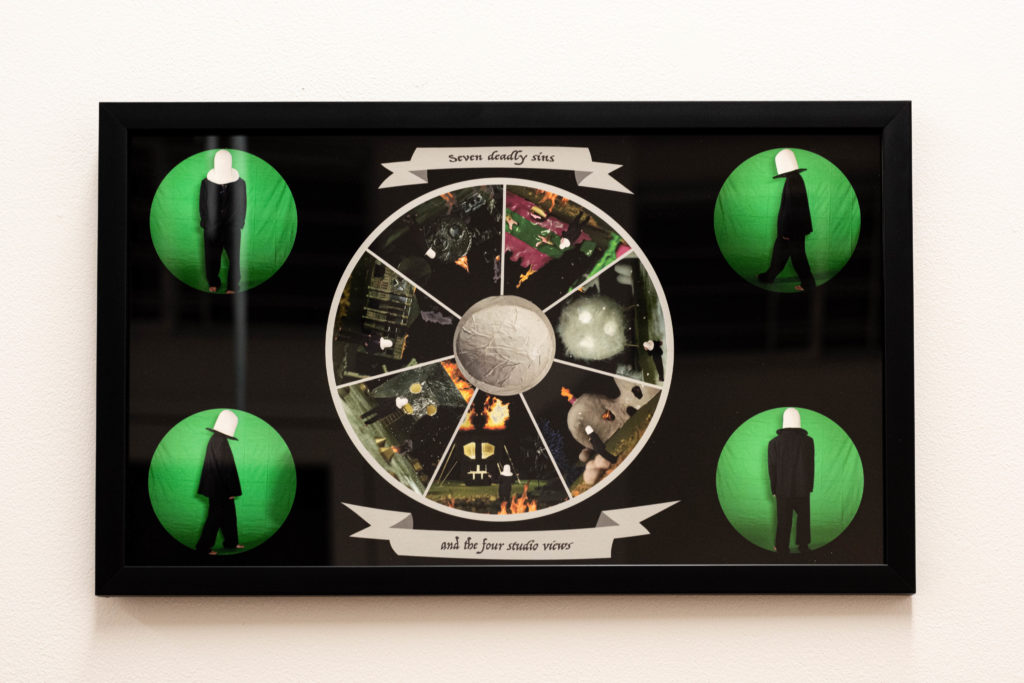





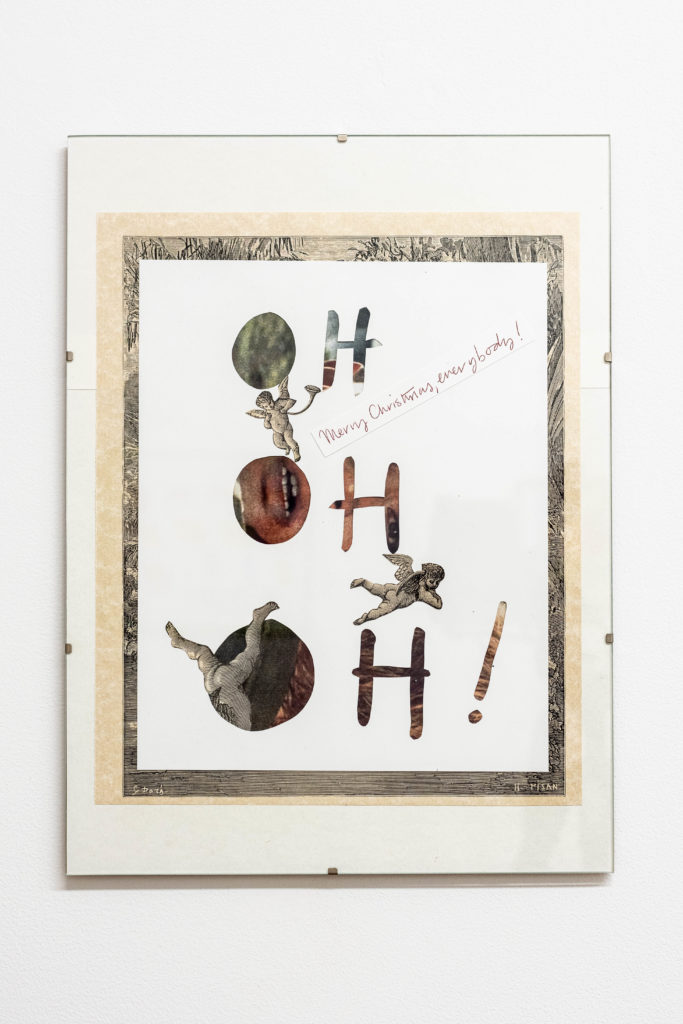
Men’s World- Desire, Mysticism, and Preposterousness. September 15 to October 31, 2021
Satoru Eguchi, Nicolas Guagnini, and Benjamin Horns.
I wonder why Murasaki Shikibu wrote The Tale of Genji*? I also wonder if the character Genji was only one person? Or, if the author made up one long story that mixed many male personalities into one man?
Why did James Brown write the song It’s a Man’s Man’s Man’s World? Was it a confession that men are like worker bees? The lyrics say that He is the one who runs society, but he also can’t live without a woman. It’s a surrender of the tendency of Men’s self-assertion. I don’t hate it, but I wonder if this is okay?
My favorite chapter in The Tale of Genji is Hahakigi, a well known chapter also remembered as Amayo no Shina Sadame* which shows both man’s true intentions and man’s meanness.
When I saw Nic’s hyperbolic white busts with male genitals protruding out from the eyes, at a group show at Bortolami Gallery in Tribeca NYC, his busts were surrounded by musical theme paintings and I thought: this bust belongs to James Brown.
In my imagination I tend to see the world through my favorite story: Alice In Wonderland.
Satoru’s fountains suggest those found in Genji’s garden during the Heian period* and Ben’s paintings present views of the scenery beyond the garden, mysteriously hazy.
I wonder how you will view the show and what you will see in it. Mieko Meguro
The Tale of Genji* was written in 1008 by Murasaki Shikibu (976~978–1026~1031). She is widely considered to be one of the world’s first novelists.
Amayo no Shina Sadame* is one of the chapters of Tale of Genji. It translates into English as Appraising In A Rainy Night.
The Heian period* was from 794 to 1185.
Nicolas Guagnini was born in Buenos Aires, Argentina, in the sixties. He doesn’t ride horses but his mother was indeed a psychoanalyst. He’s a poet, he’s a father; and thanks to his classical foundation in the fine arts he may draw, paint or sculpt. Prose does not elude him either. He lives uptown in Manhattan.
Satoru Eguchi was born in Niigata, Japan. He moved to NY in the late 1990s and studied painting at the School of Visual Arts. He has had solo and group exhibitions at Young Knee Kool, NY (2019), 3A gallery (2017), Sometimes (Works of Art) NY (2014), S.M.A.K.,Ghent, Belgium, (2009), Misako & Rosen, Tokyo (2008), and Japan Society, NY (2007). He currently lives in Brooklyn and works in Long Island City, New York.
Benjamin Horns was born in Palos Heights, Illinois, and currently lives and works in New York, NY. He completed a BFA at The Maryland Institute College of Art and a Meisterschuler at Städelschule in Frankfurt, Germany. Recent exhibitions include Condo Shanghai, A+ Contemporary, Shanghai (2019), New Social Portraits, Springsteen Gallery, Baltimore, MD (2017), and Federico Vavassori, Milan, IT (2016). He will participate in the The Whitney Independent Study Program in 2021- 2022.
Photos by Audrey Kenison.













Place Space Void: Anne Daems, Kate Harding and Frances Scholz. April 19 to May 23, 2021
Taking its title from the writings of architectural theorist and urban planner, Gunter Nitschke, the exhibition, Place, Space, Void, speaks to the multifarious uses of the Japanese term ma é = space, that is understood by Nitschke to be the product of lived-space and lived-time. Alongside this overriding theme, he also points out that in Japanese, the written characters for time” æ‚ é–“ (-jikan) (literally: time-space) can be expressed as space in flow, making ecologies of time the element that compliments space.
Drawing on architect Isozaki Arata’s concept time = chronos + ma, and space= void + ma., to stress the importance of the space between one object and another, Nitschke also suggests that when ma is consciously included in our thinking, it can become a unifying bond between the creator, the image and the viewer. Whether one upholds the distinction between the existence of the void (the universe) and its infinity; the permanent and the temporary, or inspired by the nature of space and the weight of reality, memories, images and words make us who we are.
Place, Space, Void, is a timely group show as each of the three artists explore numerous local and global interstitial spaces that they themselves and societies/communities continually have to navigate and inhabit in our current situation. They range from mapping personal geographies and private spaces, the body, psychological space, interiors, to the exterior world of nature, the urban landscape and architectural spaces. All three artists have lived and work between various countries, places, cities and time zones, yet at the same time they coexist in what the sociologist Manuel Castells, speaks of as the processes of timeless time and space of flows, two specific features that represent new configurations and a complex web of, local, global and digital flows. For Castells, future cities, are not centres such as; London, New York, Tokyo or Johannesburg, instead he debates the argument that they become a feature of the connectedness of a global network society, what he is calling transformation of space and time in the human experience, as he states,
… it is the part of each which is connected to an analogous part in each of the others. The global city is a distributed phenomenon. There is only one global city, and it floats on top of the others like lace.
Curated by Pamela Kember
ARTISTS PAGES
Anne Daems
Artist’s Statement
Making drawings, photographs, videos and installations is a way of navigating through our complex world and drawing attention to the social and physical mechanisms that form the basis of our human condition. By focusing on the everyday details of life and pulling them into light, they can be meticulously analyzed and dissected into fragile fragments full of meaning and beauty. There are no grand gestures, there is no spectacle, nothing is important, and yet everything has meaning.
Brief Bio:
Anne Daems (1966) lives and works in Brussels and has exhibited internationally at De Pont Museum, Tilburg (NL), The Drawing Center, New York (US), Tokyo Opera City Gallery, Tokyo (JP), Museum Ludwig, Cologne (DE), Witte De With, Rotterdam (NL), Objectif Exhibitions, Antwerp (BE), CIC, Cairo (EG), Domaine de Kerguhennec, Bignan (FR), Printemps de Septembre 2004,Toulouse (FR), Laura Bartlett Gallery, London (UK) and Nicole Klagsbrun Gallery, New York (US). She has previously collaborated with Kenneth Andrew Mroczek on projects, Opa-Tisha-Wocka-Locka (MER book) and When The Linden Blooms for Muse Matisse, Le Cateau-Cambrsis (FR). Last year she had a solo exhibition at 3A Gallery, New York. She completed her studies at LUCA School of Arts, followed by a postgraduate residency at the Rijksakademie in Amsterdam. Daems is a recipient of the Belgian Art Prize (Prijs Jonge Belgische Schilderkunst), and currently a professor at Sint Lucas in Antwerp. Her upcoming solo exhibition Tuinkamer (Garden Room) opens at Bozar in Brussels on May 13th. She is represented by Micheline Szwajcer.
Kate Harding
Artist’s Statement
My fragmented and decentralized works subvert historic conventions of depicting nature as comprehensible at-a-glance, to make spaces of intimate and shared reflection. In recent paintings, drawings are translated into layered digital embroidery and in combination with painting, draped and sewn linen and gesso engage qualities of shifting light. Garment making often provides both a physical and metaphoric structure in my work. The materials refer to the tradition of landscape painting, while the thread image becomes part of the fabric itself and is obscured by the folds and shadows created by its manipulation.
Brief Bio:
Kate Harding is an interdisciplinary artist based in Brooklyn, New York. She was born in Martinsville, Indiana, grew up in rural Missouri and received her MFA from SVA Art Practice, New York (2014), her BFA from Otis College, Los Angeles (2003) and AAS from SUNY Fashion Institute of Technology, New York (2001). Solo and two-person exhibitions include 3A Gallery, SARDINE, and Grace Space (NYC); Track 16 (Los Angeles); and East Central College (Missouri). Recent group exhibitions include The Agnes Viras Art Center at Urban Glass, Paradice Palase, Art in Odd Places, 3A Gallery (New York), and LADIES ROOM, Tiger Strikes Asteroid, and Track 16 (Los Angeles). Harding received the UrbanGlass Winter 2020 Scholarship to study neon bending. Her work has been reviewed in Mapping Meaning Journal, The Brooklyn Rail, Artscene, ArtFile, Notes on Looking, FiberArts Magazine and others. Harding’s writing has appeared in The Brooklyn Rail, Tool Book Project and Cafe Dan Graham Poetry Slam, vol. 2 and she hosts the radio show Bicoastal Carpool on WPIR broadcasting from Pratt Institute in Brooklyn, New York. Harding teaches at Parsons the New School of Design and Pratt Institute.
Frances Scholz
Artist’s Statement
Projection and painting are interchangeable in the work, with no particular hierarchy. There are no moving images, yet there are no images that are not moving. The painted surface functions not as an image, but as a visibly transparent membrane through which moving images can shine through. Maybe in my film the opposite is true.
Brief Bio:
Frances Scholz was born in Washington D.C. and studied at the College of Fine Arts, Berlin.
Since 2002 she has been a professor at the Braunschweig University of Art/HBK (DE) and lives and works in Cologne. Her work has been the subject of solo exhibitions at venues including Abteiberg Museum Inchengladbach (DE), CCA Wattis Institute San Francisco (US) and the Chinati Foundation, Marfa,(US). Further on institutions like the KunstMuseum, Bonn, (DE), Museum Ludwig, Cologne (DE),Chisenhale Gallery, London (GB), CAPC Museum, Bordeaux (F), Witte de Witt, Museum Rotterdam (NL), MOCA, Museum Los Angeles (US), Galeria Studio, Warsaw (PL), ICA, London (GB) or Artists Space and The Kitchen, New York (US) screened her films and presented her paintings.
Photos by Audrey Kenison.







Heidi Schlatter: 80/20. March 1 – April 4, 2021.
3A gallery presents a solo exhibition, 80/20 by Heidi Schlatter. With this work, Schlatter further explores her central theme of the relationship between architecture and systems of power.
In light box displays, grainy midair drone shots of urban residential building sites present views of unfinished, cave-like spaces not usually visible from the street. Images of raw materials are frozen mid-construction, single bulbs illuminate multiple floors, glittering like priapic jewels in the night sky. In the context of the current polarized economic environment, this exhibit considers the subtle violence presented by the ubiquity of these luxury buildings. Its title is taken from the real estate term 80/20, often used when a certain percentage of apartments in new construction can be given over to affordable housing, which in reality are often a justification for market-rate subterfuge.
There is a fundamental principle known as the “80/20 rule”. This is also often called the “Pareto Principle”. It was named after an Italian economist, Vilfredo Pareto, over a century ago in 1895. He noticed that people in society seemed to divide naturally into what he called the vital few, or the top 20 percent in terms of money and influence, and the trivial many, or the bottom 80 percent. Later, he discovered that virtually all economic activity was subject to this principle. Pareto’s 80/20 rule can be applied to almost any situation and is profoundly relevant to being a successful realtor.-Joseph James Realtors
“I’m not paying 17 million for a penthouse when the balcony ain’t even in the living room!” Michael Sorkin (What Goes Up)
Photos by Alex Yudzon.

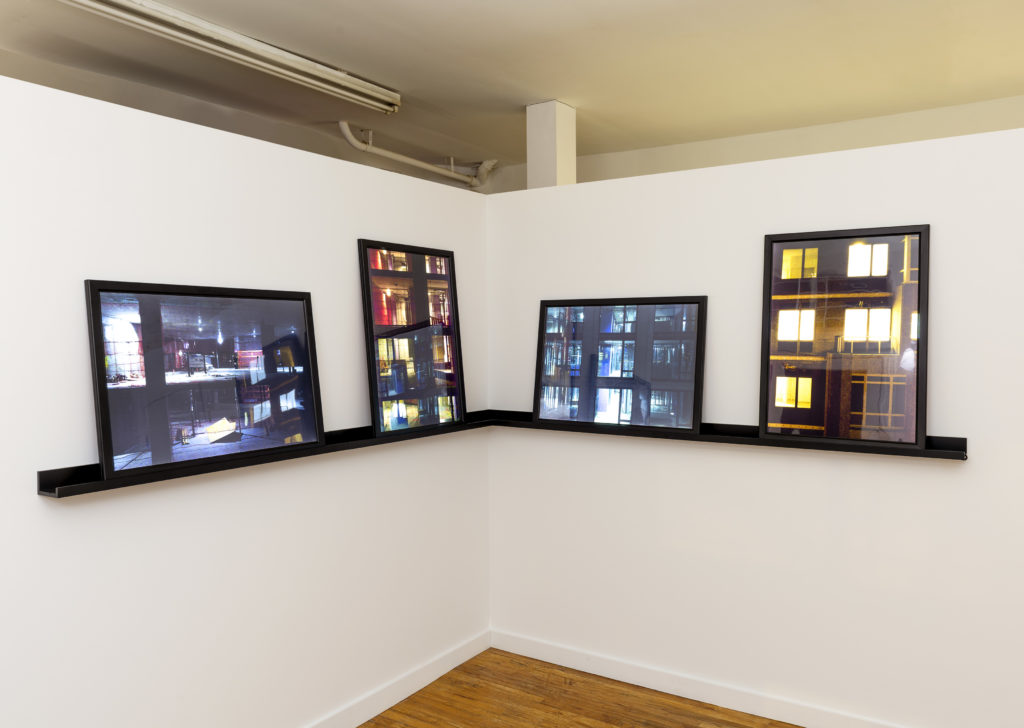
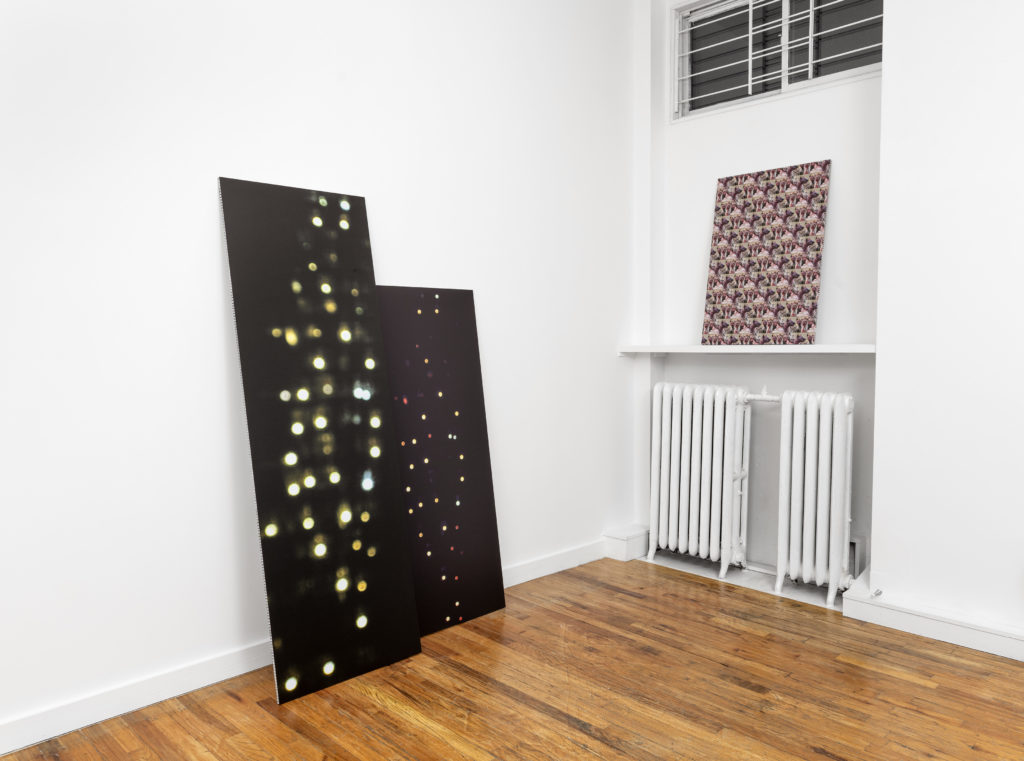

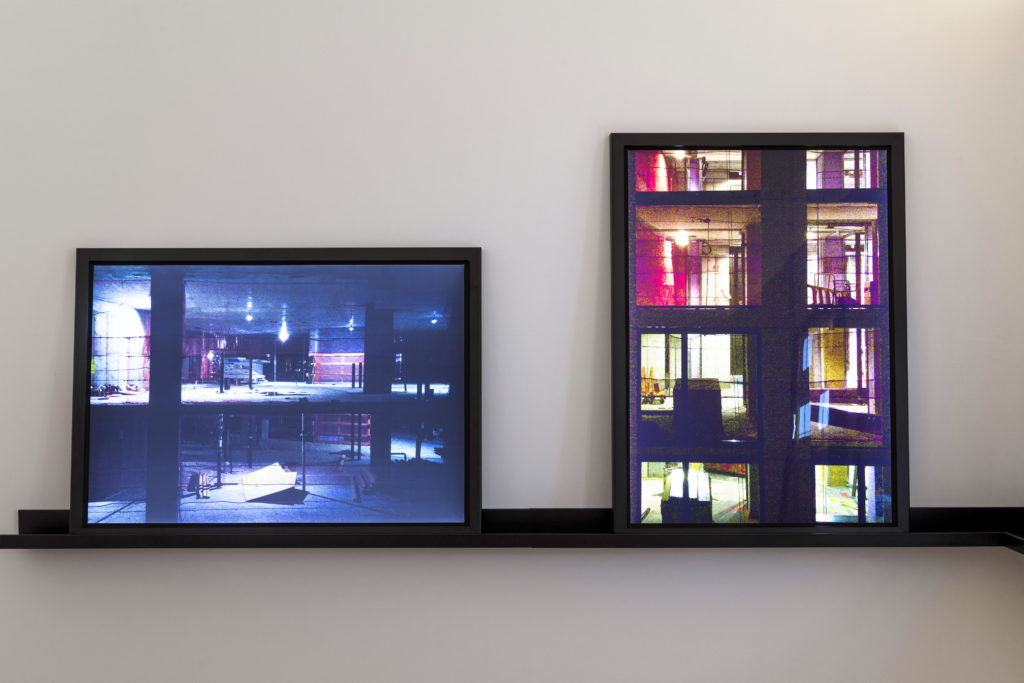



Late Summer Show: A Group Exhibition. September 5th to October 25th, 2020
Rafael Delacruz, Satoru Eguchi, Wineke Gartz, Kate Harding, Maki Kaoru, Mieko Meguro,
Quintessa Matranga, Keisha Scarville, Trevor Shimizu, Tracy Dillon Timmins
Late Summer Show:
Since the pandemic has happened we all have been forced to live this surreal reality. No museums, no galleries. No arts means no life for us. Thank God we are slowly recovering, and life has come back to us little by little. I appreciate that 3A Gallery is also able to open again. This show has no theme as a group show. All participating artists are friends. We confirmed we are all surviving. How lucky we are. Thank you so much. I am very sorry if you lost your loved one. I hope you recover well if you are struggling with the disease now. For the hard work of the first responders and essential workers, thank you so much.
Sincerely, Mieko Meguro
Photos by Alex Yudzon.



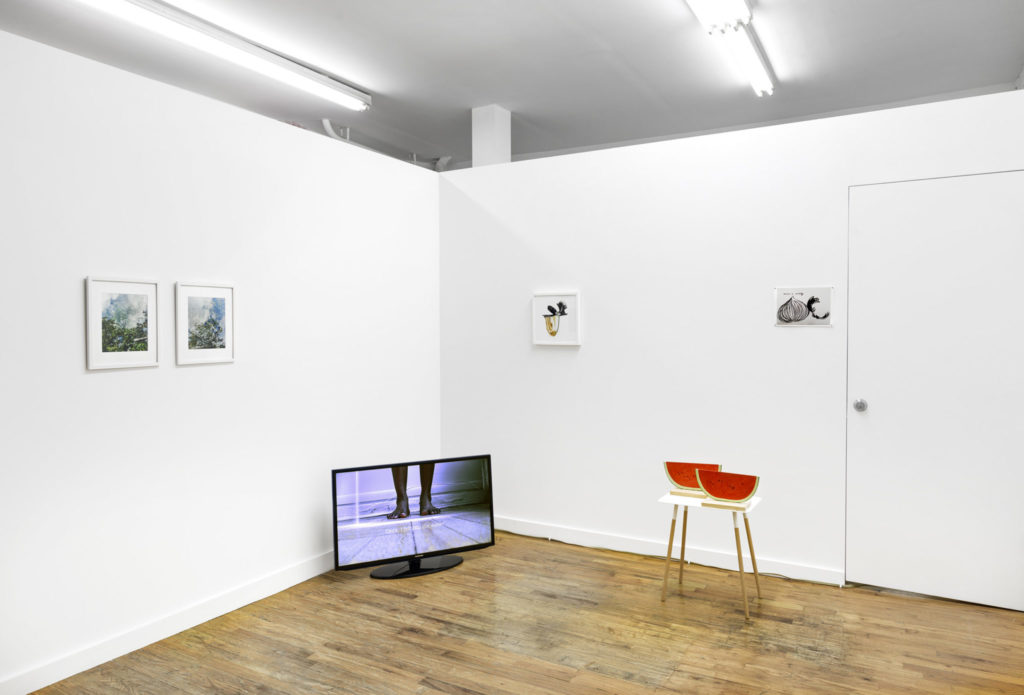



Anne Daems: “Parsnip Peel Ochre Grated Radish Pink Sap Green Polka Dots Lava Cake Black”. Feb 28th to March 28th, 2020
At first sight Anne Daems’ series of watercolor paintings look like colorful impressionist landscape paintings inspired by for example Monet or Bonnard. Those believing that Anne Daems turned to abstract painting might come back from a naked trip. Her series of drawings is an ethnographic detailed study of garments on a Gustave Serrurier-Bovy chair in her bedroom. The for the most part invisible art-nouveau chair covered with clothes is turned into an endless composition machine for random color charts and patterns of contingent landscapes. In the viewers daily, petty annoyances about absolutely nothing, Anne Daems triggers important questions like: Who is dressing the chair every day? Does the chair witness the mood of the undressed on that day? Or on which moments do smelly clothes leave the chair and end up in the washing machine?
Maria Bovy
Photos by Jeffrey Sturges.





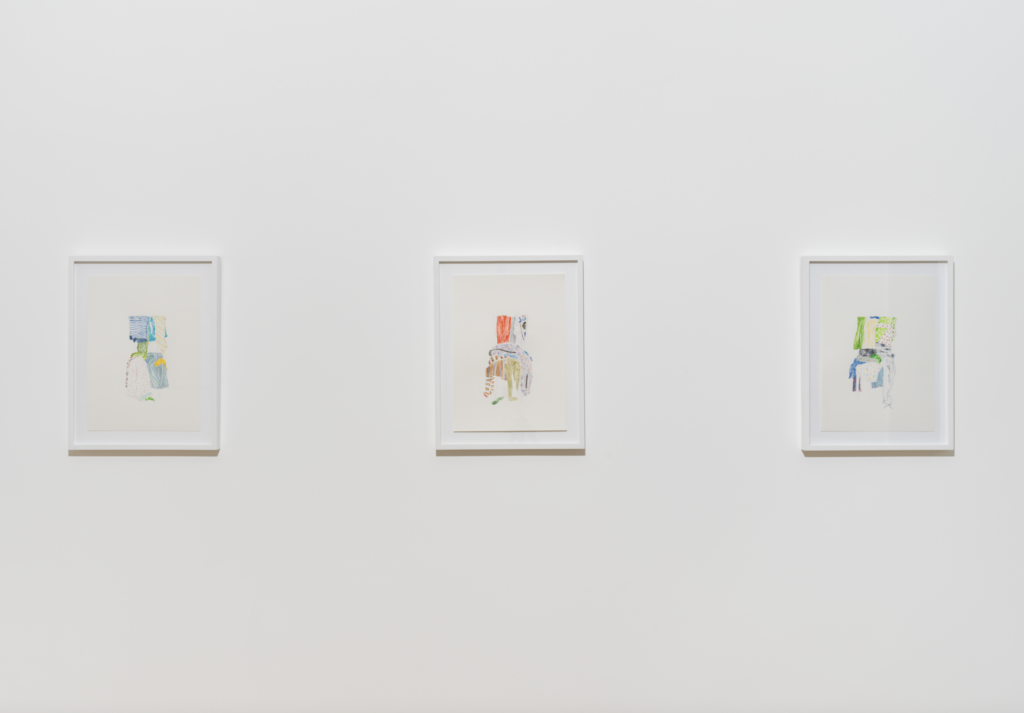
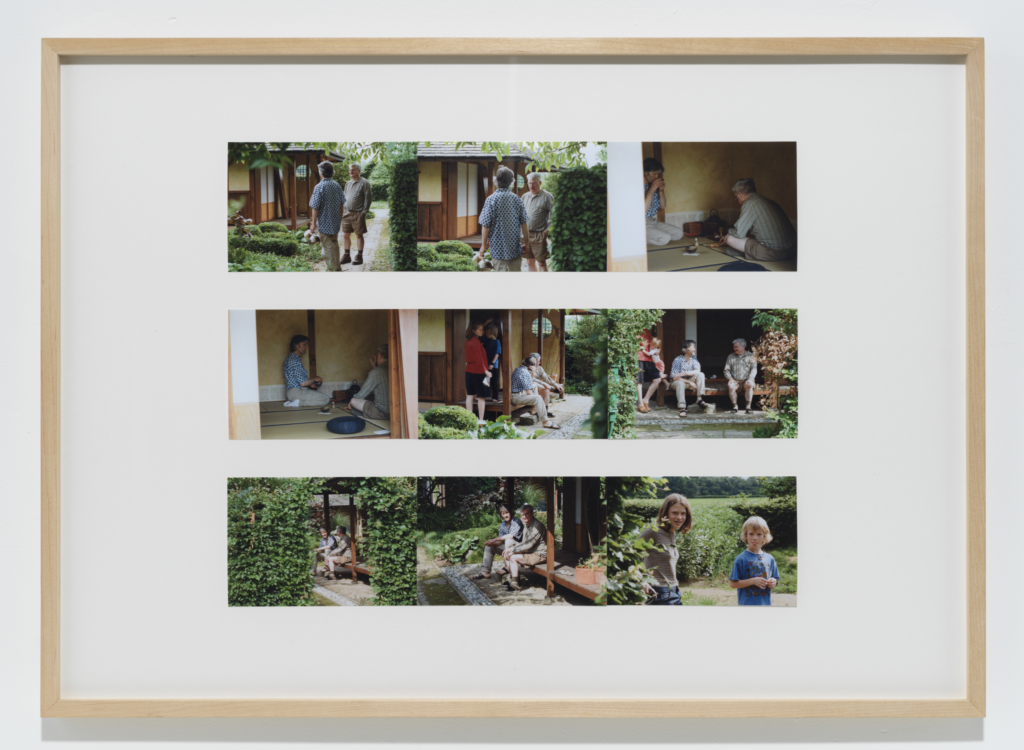
Max Schumann: Tonight Where You Live. December 15, 2019 to February 2, 2020
In his first solo gallery exhibition in nearly ten years, artist Max Schumann makes a new pairing of two different painting series. Painted with acrylic and house paint on synthetic fabric, the series “Tonight Where You Live” was made in 2009, and is based on snapshots off the TV screen depicting a local New York City weather forecast. Created in the mid 1990s, the series “Banana Republic” is painted in acrylic and house paint on National Geographic magazine covers, depicting a wheatfield copied from an advertising campaign for the clothing company Banana Republic. Countries that the U.S. invaded or militarily intervened in are listed on the paintings with the dates of involvement.
Since being coined in the early 20th century, “banana republic” has mostly been used as a pejorative term for so called “third world” countries which are politically and economically unstable. Now in the early 21st century a banana republic is what the U.S. has in many ways become.
Photos by Jeffrey Sturges.







Kate Harding: “Field Experiments in A Long and Short Time Comin: Seeing it Through/Seeing Through it”. September 20th to November 2nd, 2019
I like Kate Harding’s pen drawings. Her drawings bring to me on a fantasy about a Nineteen Century America. Her detailed drawings remind me of Huckleberry Finn’s adventures. I wonder if maybe he is there, and plays around in her drawings. Then I think of a young boy, George Washington cutting down the cherry tree. My mind also takes a trip to the vast landscape of America as in Thomas Cole’s paintings.
When I was a child, my American symbols were Marilyn Monroe, James Dean, and Norman Rockwell’s illustrations. However, Kate’s drawings invite me to an earlier period in American history. Finally, my mind goes on another trip, and I think of Ed Ruscha’s big mountain paintings.
In Kate Harding’s second solo exhibition with 3A Gallery, she will be showing an installation of works that are the result of an intensive period of exploration integrating drawing, painting, and digital embroidery on draped and sewn linen.
I hope people enjoy seeing her works and their imagination would travel to many periods of American feeling.
Mieko Meguro — Aug 2019
An intimate dialogue between Kate Harding and Jovana Stokic, introduced by Magnus Schaefer, and to include screenings of Harding’s video in the context of the exhibition. On Sunday, October 27th. Open from 1 pm; the talk starts at 2 pm.
Kate Harding is an artist living and working between New York and rural Missouri who examines the specificity of site and the local to explore concepts of landscape and inter-subjective perception. Exploring the relationship of language and topology, she regularly uses her body’s movement through landscape as a tool of measure, in a process of field experiments. Harding’s systematic approach to mapping terrain intersects with speech and movement, inviting consideration of embodied communication and ways of knowing and memory. Interdisciplinary in material and approach, Harding’s background in garment design and construction often provides a metaphoric structure to her work, as does research in science, history, critical philosophy, folklore and the colloquial phrase. Regularly engaging in collaborative and curatorial projects, Harding is the host of Bicoastal Carpool, a weekly radio program airing live on WPIR Pratt Radio since 2016. She currently is faculty at Parsons, The New School in New York City and Pratt Institute in Brooklyn.
Jovana Stokic is a Belgrade-born, New York-based art historian and curator. She holds a PhD from the Institute of Fine Arts, New York University. Her dissertation, The Body Beautiful: Feminine Self-Representations 1970-2007, analyzes works of Marina Abramovic, Martha Rosler, Joan Jonas particularly focusing on the notion of self-representation. Stokic was a fellow at the New Museum of Contemporary Art, New York; a researcher at the Whitney Museum of American Art, New York; the curator of the Kimmel Center Galleries, New York University; and the performance curator at Location One, New York. She is currently on the faculty of the MFA Art Practice, SVA and NYU Steinhardt Department of Art and Art Professions. Her book on contemporary performance art will be published by Bloomsbury in February 2020.
Magnus Schaefer is an art historian, writer and curator, and lives in New York.
Photos by Jeffrey Sturges.
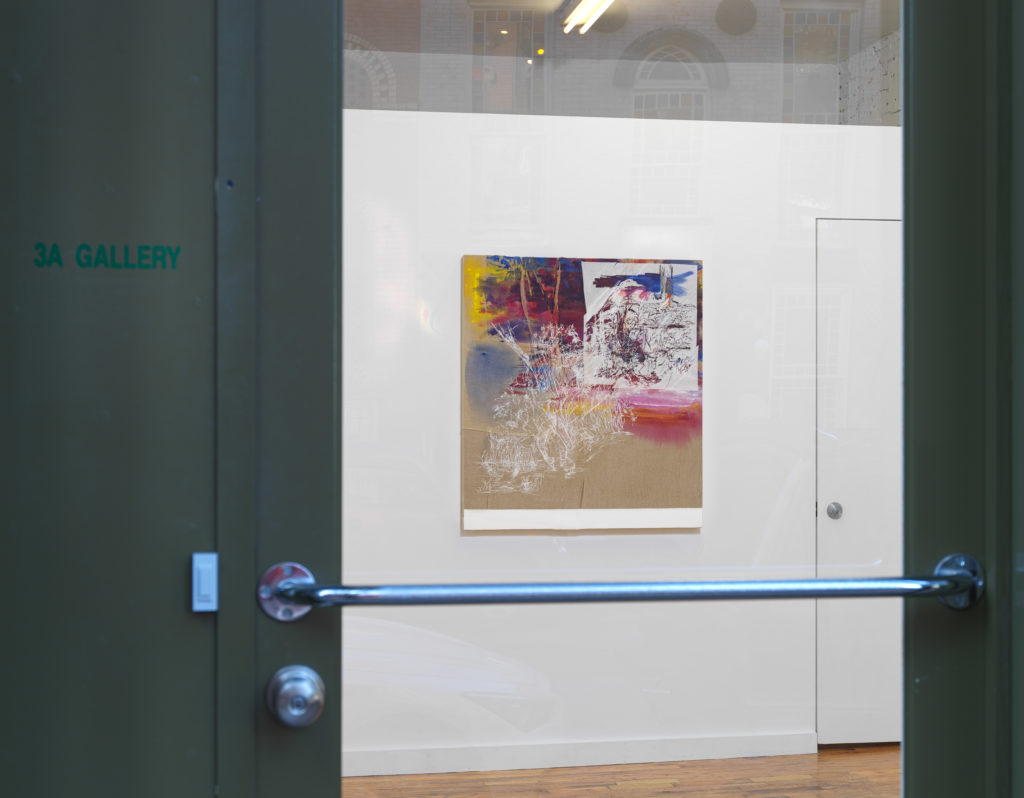



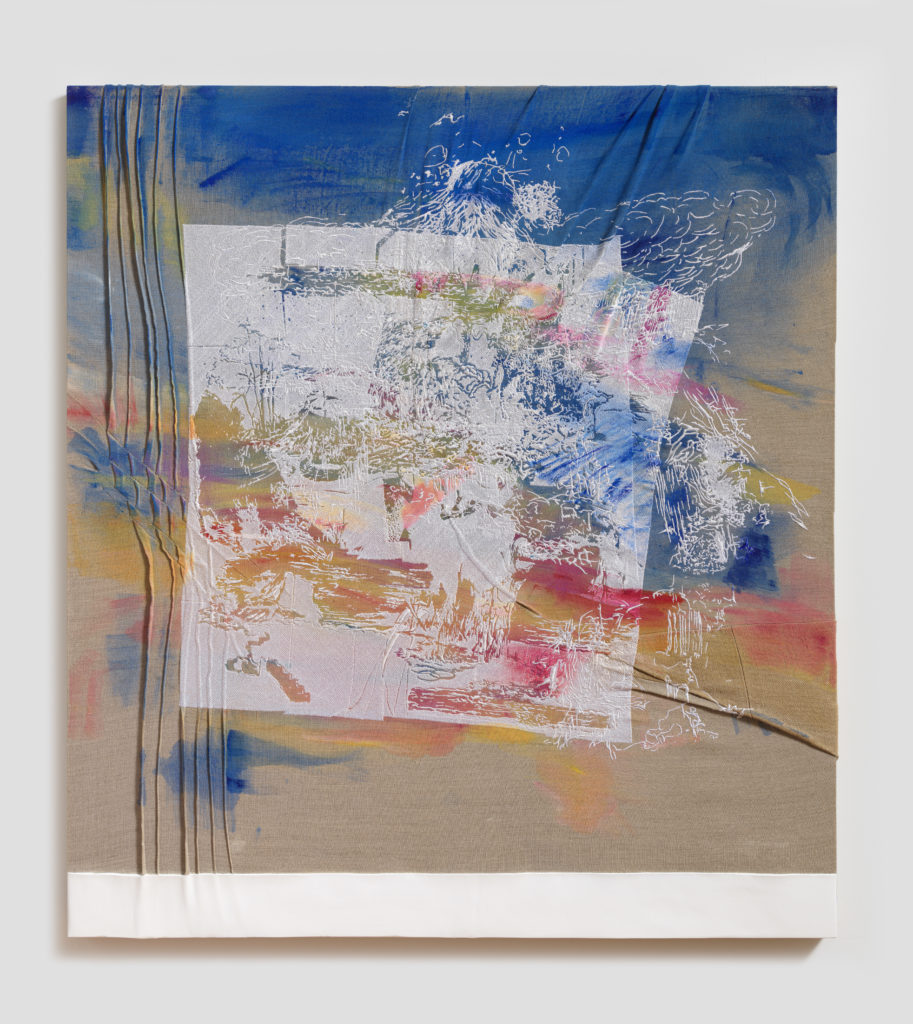


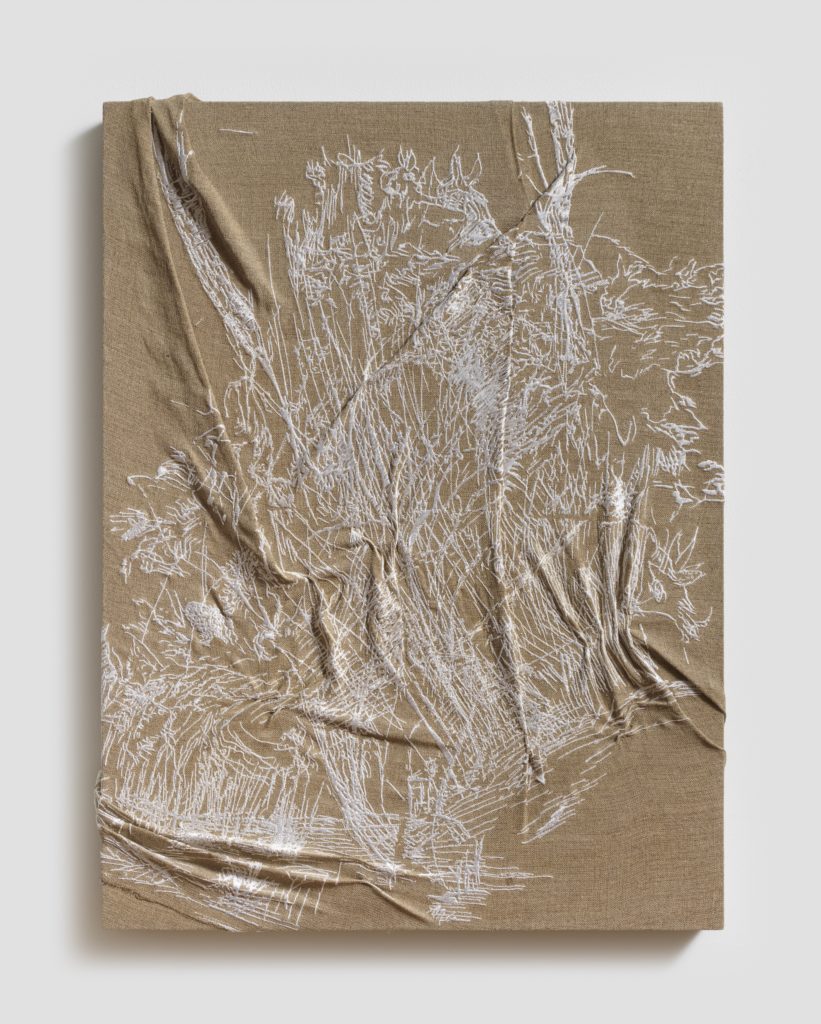
Food Show 3. June 2 to July 7, 2019
Rafael Delacruz, Satoru Eguchi, Barbara Ess, Wineke Gartz, Dan Graham,
Erika Landström, Satomi Mastuzaki, Quintessa Matranga, Laura Medellin,
Mieko Meguro, Yuki Okumura, Trevor Shimizu, Michael Smith, and Christopher Williams.
One bite of Madeleine took you back to all the memories of Proust’s life; I understood this sensation.
It is not easy for me to eat raw tomatoes because of my memories of my mother and her mother. My mother’s family were farmers; they grew vegetables. One summer my mother and her mother went out to their land to pick some tomatoes as souvenirs. The two ladies were so happy and innocent; chatting, laughing and picking tomatoes. I was a little girl, and following them, I observed them with affection. This summer was the last summer when they were happy. After then, my grandmother’s health declined. When I eat salad, the smell of the tomato still brings me back to the time on the farm. For this reason, it is not easy for me to eat a fresh tomato, but I still love tomatoes.
Food gives us pleasure and memories. I still eat food every day. Mieko Meguro, April 2019
Photos by Jeffrey Sturges.
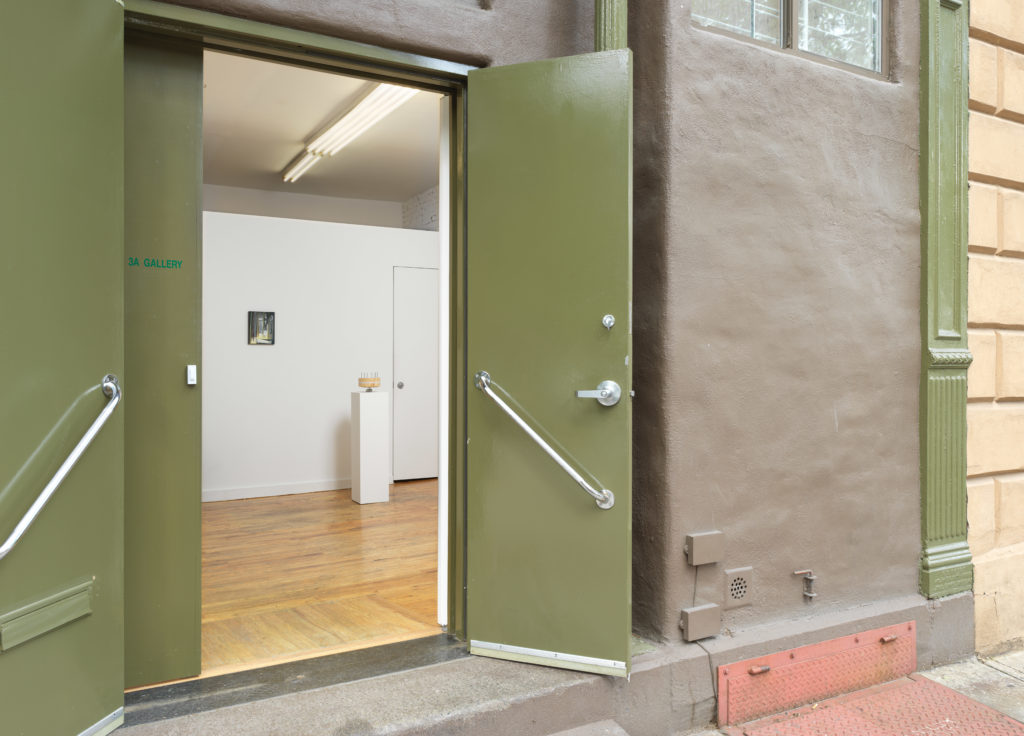
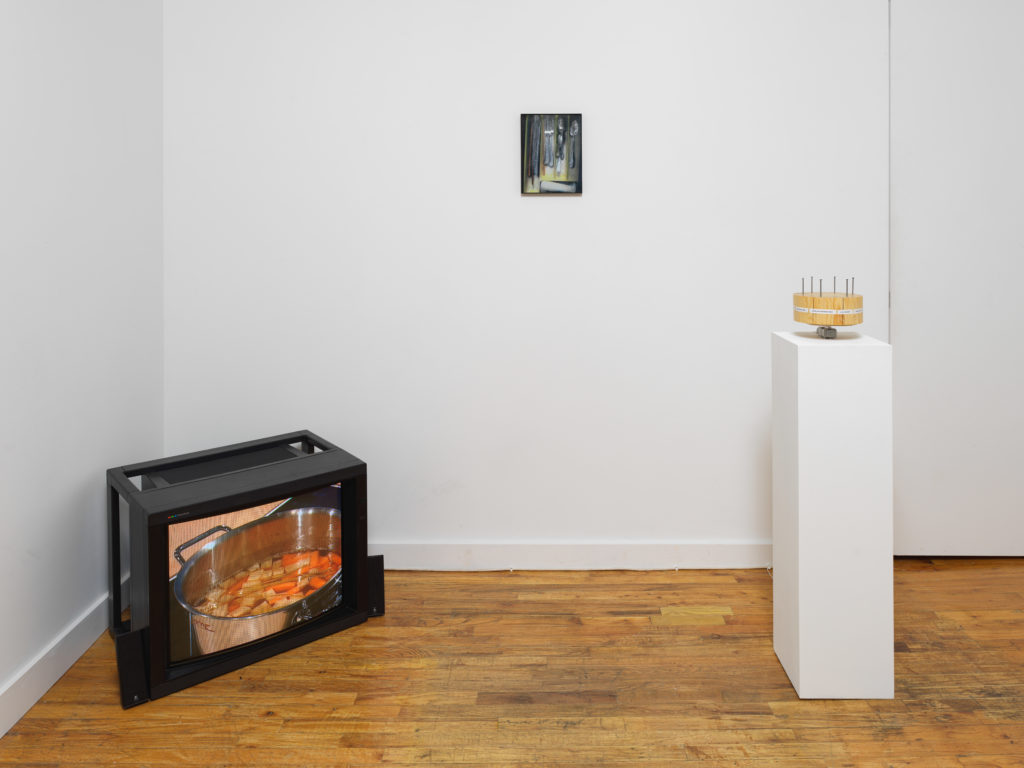



Frances Scholz : The Chicken Truck. February 8 to March 10, 2019.
Frances’s “Uncombed” images in their varied repetition figure something in a peripheral sense, like a séance or laps of photographic developer fluid running over their surfaces. In the aftermath of an iridescent oil-rain puddle drive-through, we catch glimpses of what went by. Her recent “Non-portrait” operate similarly; spilling, blotting, and taking away fragments of partial view. The nine new pictures in this show, which relate to those larger bodies of work, are tethered to memories, or to a film still distorted, an evaporated image projected onto a model of a room, or a painting scaled down and re- configured into a watercolor. Swipes, dissolves, and recollections of a glance are exchanged—between a visitor and a West Texan horse, a passerby and a desert food stand. Three dimensions seep and fold in and out of the space of these small pages, and the sun hits one majestic face of the chicken truck.
In transitioning fluidly between film shooting and painting, Frances strings narrative into formal means and vice-versa. Not to endlessly defer in the sense of vapid/reflexive abstraction, but rather to work at something more genuinely or stubbornly noir. In one of her earlier videos that could also be dubbed a non-portrait, Wir kennen uns übrigens (We know each other by the way), 1998, the artist’s bag is emptied out in its entirety multiple times over, a cover of or take on Jane B. par Agnes V.. In these small works on paper, we get tangles again from sources inverted.
—Annie Ochmanek
Photos by Jeffrey Sturges.
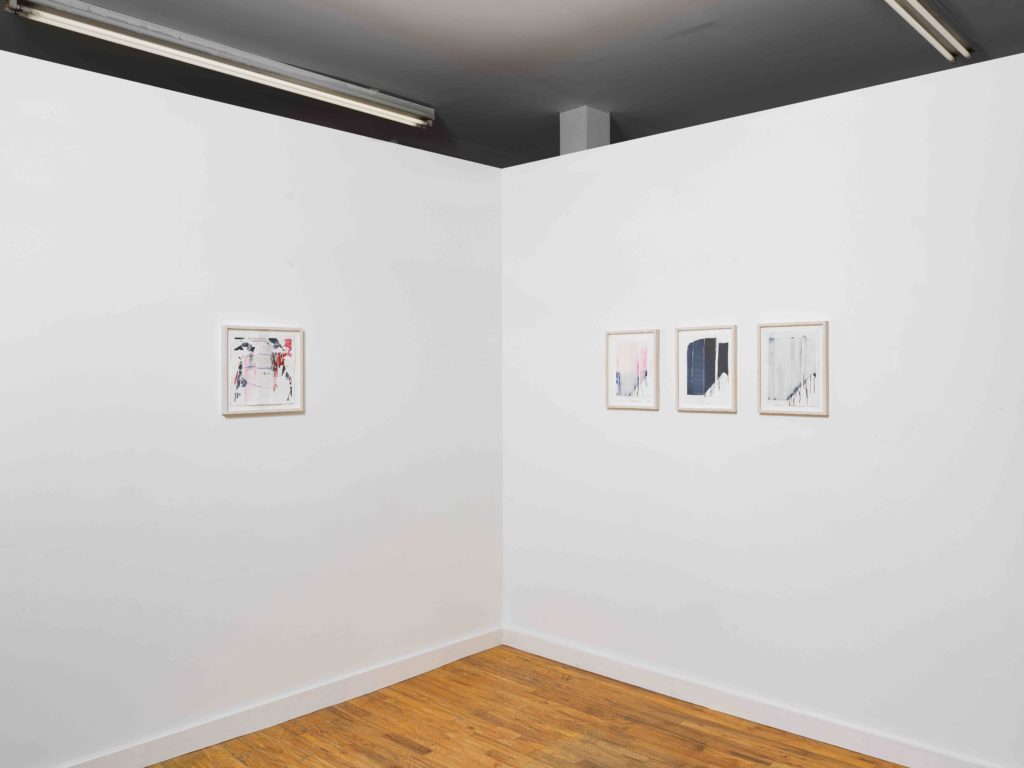
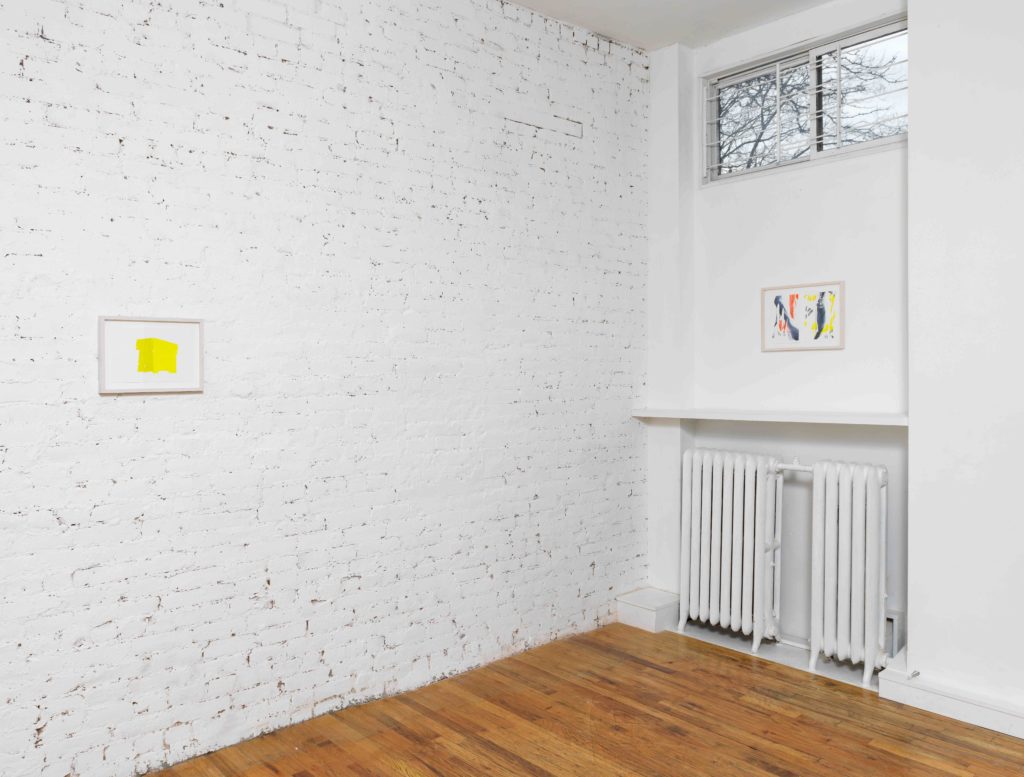

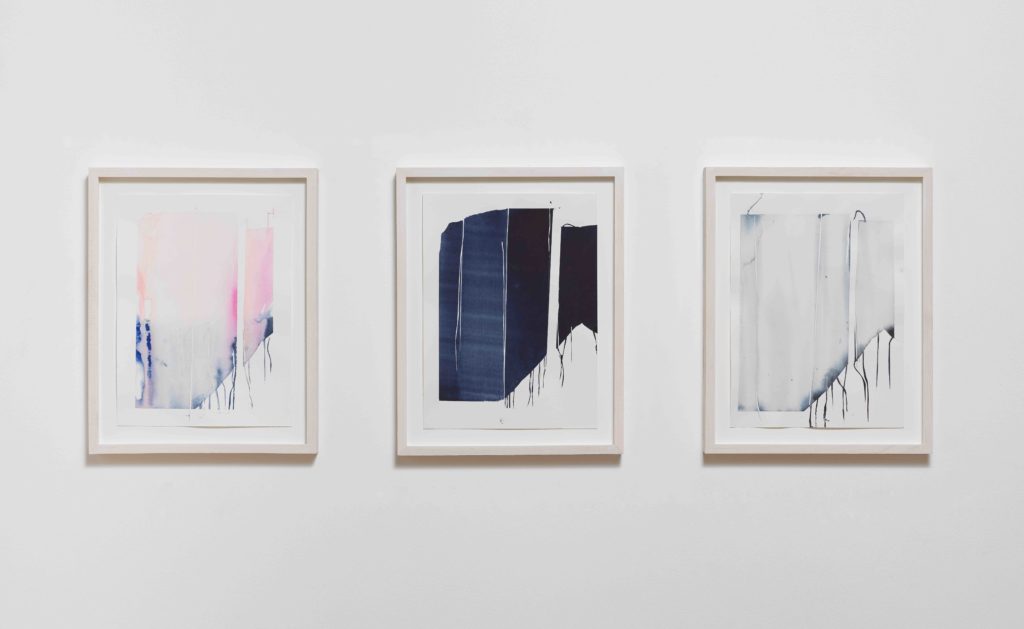

Barbara Ess: Lunatic(k). November 11 to December 30, 2018
A photo and video installation concerning the mind/body problem* by Barbara Ess
Things are not always what they seem to be. There’s the thing. There’s perception and thought. But in The Expression of Emotion in Man and Animals published in 1871, Charles Darwin quotes Dr. J. Crichton-Browne’s theory that “an empirical confirmation exists in insane people between the state of the their hair and the state of their minds.”
*music by Slayer
Photos by Jeffrey Sturges.
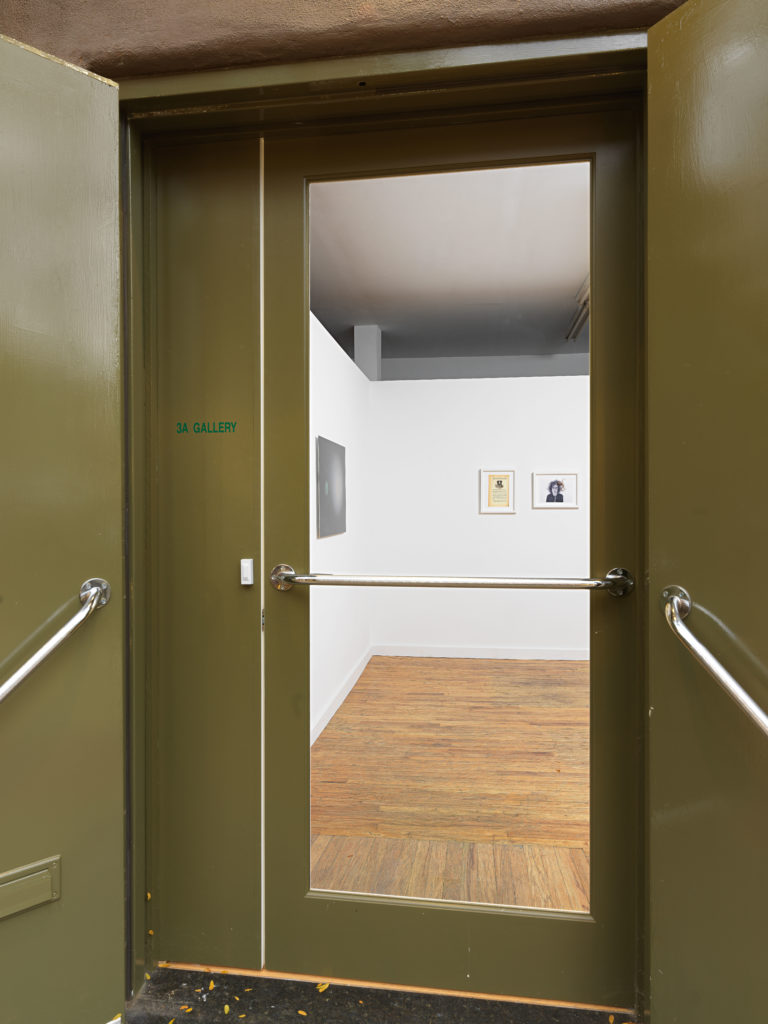





Arvid Logan: Repellent. October 7–14, 2018
The SMET group is beginning construction of their new rail lines, however the Insectoids have become a liability to their transit expansion plans. The SMET group forms CTON, an anti-insect task force subsidiary. Stage 1 of the CTON initiative is to start misting their newly developed PX-Sprëj, a repellent specially formulated to exterminate the Insectoids.
Using installation, video, painting, and sculpture, Arvid Logan pieces together an alternate world that pulls from the imagery of his childhood. Logan re-imagines the conflicts of living in an increasingly privatized and authoritative city as a war between insects and exterminators.
Photos by Jeffrey Sturges.
We are pleased to announce the launch of Dizzy Magazine‘s fourth issue at 3A Gallery, Sunday October 14. The new issue features Emma Kohlmann, Susan Cianciolo and Lilac Sky, Alake Shilling, Maya Maxx, and more.
Dizzy is a New York based publisher and intergenerational print magazine focusing on the arts: painting, writing, film, music, style, and more. Featuring artists from diverse backgrounds, Dizzy strives to bridge gaps between age and exposure. Dizzy’s inclusion of fun sections like 12 and Under (featuring children’s artwork), Pet Page (featuring an artist’s pet), and Dear Destiny (advice column with Princess Nokia) allow the magazine to be accessible to readers of all races, genders, and ages.
“In a publishing world crowded with overreaching art journals, the magazine strikes a refreshingly unpretentious tone that aims to forge connections between communities. Flipping through the pages, I was reminded of everything from BOMB magazine, which Libin cited as an inspiration, to the legendary Midwestern graffiti magazine Life Sucks Die. It is nice to read something that makes you remember what you loved about magazines in the first place.” ARTnews
Dizzy Magazine was founded by Arvid Logan and Milah Libin in the summer of 2016.




Jeff Preiss: Title. July 15 to September 9, 2018
Performance by Andrew Lampert on Sunday, September 9, 2018, 2–5pm.
Jeff, good day, You may have seen what we called at the time it was made, the Interview with the Ambassador from Lapland. It was made by Adolfas in the 60’s when the Vietnam War was roaring in our lives. It’s 4 minutes long, 16mm sound and mainly just a shot of Adolfas in a white suit speaking his solution to financing the Vietnam War. He never put titles on it, and it was shown in those days without titles, like a clip from a newsreel.
Do you have the time to shoot a title? – “A film by Adolfas Mekas” would probably be enough – and then splice it on at the end. The Filmmakers Coop has a print and I have another. After that I would have it digitized.
If possible I would like to view it with you, if you have the time – to get your opinion. If time is a consideration, please let me know. I will cover costs, of course.
Spring truly is on its way,
Pola
March 27, 2018
TITLE for Adolfas Mekas Jeff Preiss 2018 16mm film transferred to DVD on Eight 4” LCD monitors and a projection of: An Interview with Ambassador from Lapland by Adolfas Mekas 1967 (titled version 2018) 16mm film transferred to Bluray.
50 years after Adolfas Mekas’s original act of protest, his facsimile of found-footage is reframed as memorial by the act of posthumous titling, and this reframing is framed again by a schematic mapping back to the physical space of production, evoking through its fractured mise-en-scène an homage to the under-recognized master filmmaker and teacher.
“A complex fellow was Adolfas, kept erect by his fine clothes so as not to become a puddle of feelings” —Ken Jacobs
Photos by Jeffrey Sturges.






A Talk “The Ambassador“
Jeff Preiss, Alaina Claire Feldman, and Magnus Schaefer
Sunday August 19th, 2018
Doors open 2 pm, The Talk 3pm, Doors close 5pm

Who was the Ambassador of Lapland? How might we archive that which does not exist physically anymore? And how do cameras see spaces? 3A Gallery is pleased to present a conversation with Jeff Preiss on the occasion of his exhibition TITLE for Adolfas Mekas. Joined by curators Alaina Claire Feldman (CUNY) and Magnus Schaefer (MoMA) a conversation among friends will attempt to attend to these questions, while also diving into the history of film technology and anecdotal experiences.
A Performance by Andrew Lampert
Sunday September 9th, 2018
Doors open 2 pm, The Performance 3pm, Doors close 5 pm
Hey Jeff,
Writing ahead of time about something that I won’t necessarily do, at least not as described, always gives me pause. I don’t want to reveal too much, yet at the same time realize that descriptive information helps entice a potential audience to discover, alongside me, what I’m doing. So, here it is:
Title: As Opposed To Gravity
Year: 2018
Length: Unknown
This performance will be presented alongside another piece of audio:
Title: What’s Your Favorite Movie? (Adolfas Mekas)
Year: 2010
Length: 2:37
I’m not trying to be mysterious, it’s just that what I’ll do is speculative until it happens. A plan exists, but the reality of things is that I can’t entirely predict the outcome, or how it will be experienced by those of us in the gallery, since we are all in it together. I’m committed to not knowing too much in advance about the results of my ideas.
In lieu of a better description, I might mention that As Opposed To Gravity is site-specific and made in direct response to your installation. In fact it includes your footage, which will be projected on 16mm. Your exhibit is concerned with the loop, the circle, the perimeter, and what I’m thinking to do focuses on the center, the space between. I’ll be in the middle. That’s all I can really think of to say other than that I’ll probably never do this piece again after the 3A show. Maybe that is what we should be telling people.
Thanks again,
A.
Satomi Matsuzaki from Deerhoof: Hand Drawn T-shirts and CD Pop Up Shop. Sunday July 1st, 2018, 2-5pm
3A Gallery is pleased to announce Satomi’s hand-drawn T-shirts and CD pop up shop.
Satomi Matsuzaki has been the bassist and singer of Deerhoof since she joined in San Francisco in 1995.
Satomi has created the band’s album cover drawings/paintings and design for Reveille, Koala Magic, The Magic and the most recent album, Mountain Moves. She hand draws the band T-shirts as well. They are all unique as her original hand drawings. Her T-shirts and Deerhoof CDs and 7 inch records are going to be on sale. Come hang out with her.

This is not me, Andy Warhol: Appropriations, Unauthorised Editions & Fakes… June 17 to July 8, 2018
In 2013 Daniel Brant of A&D Gallery in London curated, This is not me, Andy Warhol, an exhibition
of appropriations, unauthorised editions & fakes. As a tribute to Daniel, who died on the 19th January 2017 from complications caused by Scleroderma, 3A Gallery is delighted to be able to recreate part of that show with the assistance of his partner, Helen Clarkson.
Even before he embarked on his fine art career, Andy Warhol was happy to appropriate the work of others, mainly his mother Julia.
As ‘Andy Warhol’s Mother’, she was recognised for her calligraphy on a Blue Note Album, with an award from the Art Director’s Club. Her handwriting also appears on two other record covers designed by Warhol and on his business card. Her drawings were published as Holy Cats, one of series of books Warhol printed as gifts for his clients & close friends. Another of these books was, Love is a Pink Cake (1953), in which Warhol ‘borrowed’ elements from historical paintings.
After his move into fine art, appropriation continued to be a mainstay of Warhol’s practice. Although Gene Kornman, who took the photograph of Marilyn, felt no hostility, Warhol was sued by the photographer of the image used for his Flowers paintings. Warhol was inspired by Larry Rivers’ portrayal of Lenin in the 1973, New York Collection for Stockholm portfolio in both the subject and the artistic approach which he modified for his Lenin (1987).
Warhol took a laissez faire attitude when his own work was appropriated. Once, asked in an interview, about his technique he replied, ‘I don’t know, ask Elaine’. Elaine was Elaine Sturtevant to whom he had given one of his Flowers silkscreens so she could produce her own. Richard Pettibone, whose miniature versions of painting by Warhol and Lichtenstein have been the cornerstone of his career, found both artists to be supportive (apparently, Frank Stella was less enthusiastic).
Since the 1970’s, silkscreen prints have appeared on the market, that are almost identical to Warhol’s iconic works. The various unauthorised ‘After Andy Warhol’ prints (of which Sunday B Morning are the best known) have been well tolerated and sold in leading auction houses including Christies, Sotheby, Phillips and Bonhams. It seems there are at least three variations, all claiming a connection with the original editions. A very early edition was sometimes inscribed by Andy Warhol with the note ’This is not me’. Although we have never seen any examples we appropriated the phrase for the exhibition title.
Photos by Jeffrey Sturges.
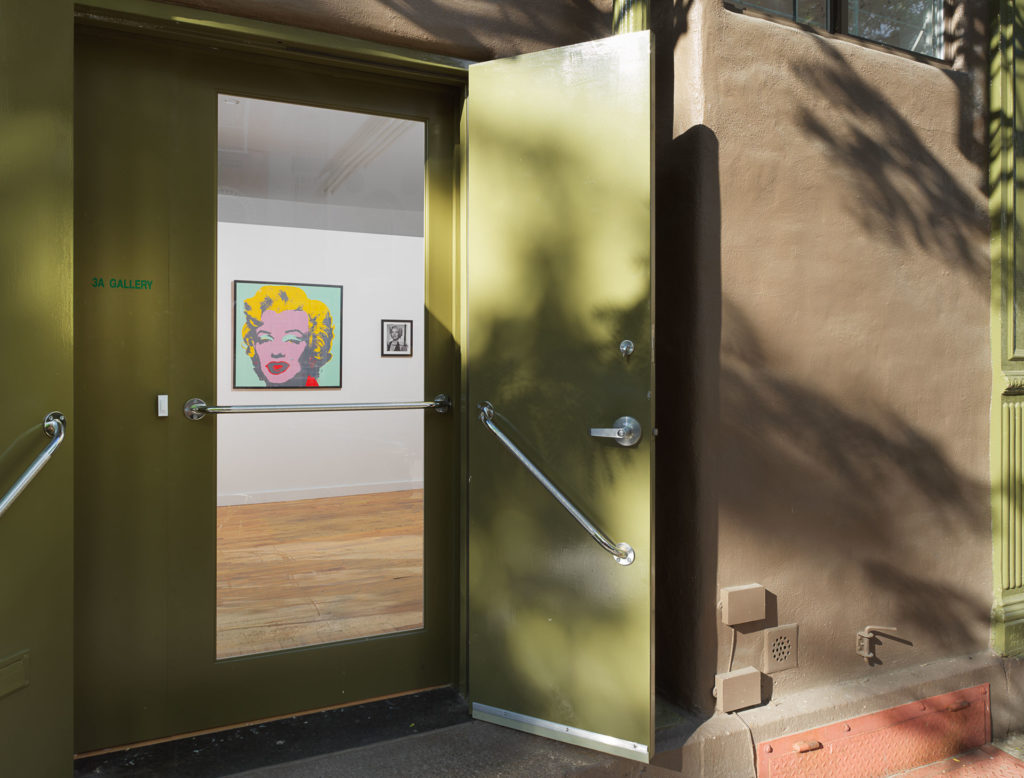



Nicolás Guagnini: The Walrus. April 8 – May 6, 2018
The American rock critic Dan Graham emphatically dislikes The Beatles. When I was younger, I thought this opinion to be historically sacrilegious –– even if I’ve always really been a Stones person. Dan claims it’s a lightweight band fit to introduce children to popular music. Now that I’m middle aged and mid-career I find myself agreeing with Dan, on the merits. However, the opening stanza for “I am the Walrus” somehow haunts me.
“ I am he as you are he as you are me / And we are all together ”
What was meant to be read, and has been read, as a psychedelic appeal to identity dissolution is also a perfect descrip- tion of the intergenerational system of legitimation between artists. I hold that construct in high regard because it sidesteps the market and general art world reception. It verifies equally across all kind of subject positions and genders, irrespective of where society is at in any given issue. This is an instance in which a relationship of friendship must be substantiated by work (and with Dan that of course includes writing), affect, and competition. The ghost of a fallout hovers due to internal or external pressures. Over decades, your intimate being and your public persona are in a perpetual status of mutual feedback in relationship to the other person. Yet elective affinities beat death, and there is a transit through influences and a dialogue with what has been as a perpetual potentiality of what must be. A friendship between artists is also the most amazing imaginary museum. Many people from many epochs sit at the table at any given time.
In the studies for this piece, and the piece itself, I attempt a direct, schematic and somewhat stupid representation of a walrus type art friendship.
Nic
Harlem, February 2018
This exhibition has been made possible thanks to the assistance of Bortolami, New York.
Photos by Jeffrey Sturges.



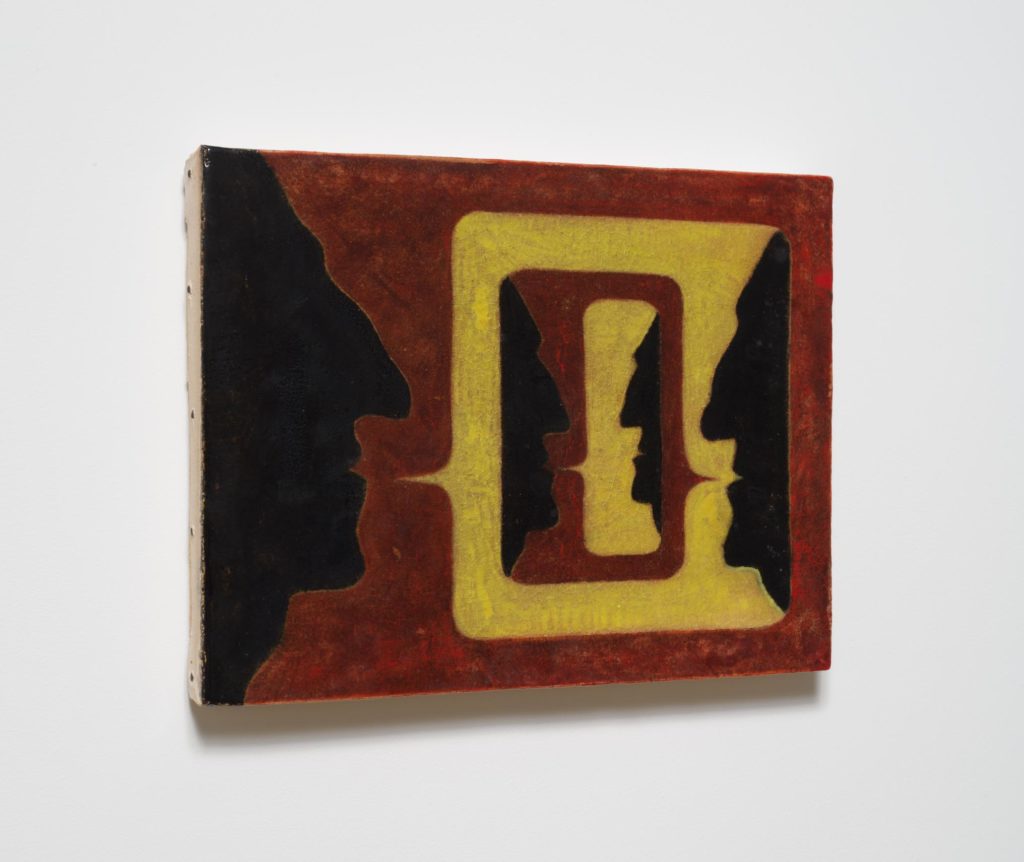
A Talk “Tres amigos y la musica“
Alexander Alberro, Dan Graham, and Nicolás Guagnini
Sunday April 29th, 2018
Doors open 2 pm, The talk 3-4 pm, Doors close 5 pm
I am delighted to announce this talk on the occasion of Nicolás Guagnini’s show The Walrus at 3A Gallery
“I am he as you are he as you are me / And we are all together”
What a peculiar poem. To me, it’s too optimistic that say And we are all together, very utopia; I don’t like the idea of utopia. I don’t believe it.
However, being in a band would be everybody’s dream, don’t you think?
Musical audiences understood musicians more than their parents.
Audiences listen to the music, then deeply think about the lyrics, and they are emotional about it.
Audiences see that the musician as an icon.
I don’t need to say anything more because Dan Graham’s Rock My Religion explained everything.
But, we still need to discuss bands, and music because out understanding never stops, and we are all involved in the culture and the society; we are still alive.
I’m glad to have this occasion for the talk of these three amazing people, each having completely different positions and of different origin.
Canadian, American, and Argentinian will talk about it. It’s very New York, which is a melting pot. They are friends.
Mieko Meguro
April 2018
Alexander Alberro, Virginia Wright Professor of Modern and Contemporary Art History at Barnard, is the author of Abstraction in Reverse: The Reconfigured Spectator in Mid-Twentieth Century Latin American Art (University of Chicago Press, 2017) and Conceptual Art and the Politics of Publicity (MIT Press 2004). He has published in a broad array of journals and exhibition catalogues, and edited a large number of books on contemporary art, most recently Working Conditions: The Writings of Hans Haacke (MIT Press, 2016).
Dan Graham lives and works in New York. Recent solo exhibitions include Red Brick Art Museum, Beijing (2017); Zagreb Museum of Contemporary Art, Zagreb (2017); The Cleveland Museum of Art, Cleveland, OH (2016); ETH Zurich, Zurich (2015); Greene Naftali, New York (2014); The Metropolitan Museum of Art, New York (2014); Le Consortium, Dijon (2011); Museum of Contemporary Art, Los Angeles (2009); Whitney Museum of American Art, New York (2009); Walker Art Center, Minneapolis (2009); and Portikus, Frankfurt am Main (2009).
His work is in the collections of The Whitney Museum of American Art, New York; The Museum of Modern Art, New York; The Metropolitan Museum of Art, New York; Walker Art Center, Minneapolis; MOCA | The Museum of Contemporary Art, Los Angeles; San Francisco Museum of Modern Art, San Francisco; Hirshhorn Museum and Sculpture Garden, Washington, D.C.; Rennie Collection at Wing Sang, Vancouver; Tate Collection, London; National Galleries of Scotland, Edinburgh; Generali Foundation, Vienna; Thyssen-Bornemisza Art Contemporary (TBA21), Vienna; Hamburger Kunsthalle, Hamburg; Friedrich Christian Flick Collection at the Hamburger Bahnhof, Berlin; Julia Stoschek Collection, Dusseldorf; Centre Pompidou Musée national d’art modern, Paris; Museo Nacional Centro de Arte Reina Sofia, Madrid; and Moderna Museet, Stockholm.
Nicolás Guagnini was born in 1966 in Buenos Aires, Argentina, and has lived and worked in New York since 1998. Recent exhibitions include Nicolás Guagnini , Lars Friedrich, Berlin, Germany; Bibelots, Bortolami, New York, NY; Our Lady of the Flowers , Galerie Max Mayer, Düsseldorf, Germany; Union Gaucha Productions , with Karin Schneider, Artists Space, New York, NY; Nicolás Guagnini / Leigh Ledare , Galerie Max Mayer, Dusseldorf, Germany; Ana and Carl and some other couples , with Leigh Ledare, Andrew Roth Gallery, New York, NY; Heads , Lars Freidrich Gallery, Berlin; Nicolás Guagnini: Seven , Miguel Abreu Gallery and Balice Hertling & Lewis, New York; The Panel Discussion, The Tennis Match, and A Bodegon , Andrew Roth, New York; and The Middle Class Goes to Heaven , Orchard, New York.
Recent group exhibitions include Publishing as an Artistic Toolbox: 1989-2017 , Kunsthalle Wien, Vienna, Austria; G2 #6: New Acquisitions Hildebrand Collection , G2 Kunsthalle, Leipzig, Germany; Bread and Roses, Museum of Modern Art, Curated by Lukacs Rondunda and Natalia Sielewicz, Warsaw, Poland; Bad Conscience , Metro Pictures, New York.
Frances Scholz. February 11 to March 11, 2018
The act of painting lies somewhere between the transformative Process of various materialities and its forthcoming contextual impact. The way we paint, as well as how we tend to understand, categorize and grade that exact painterly Procedure.
Frances Scholz’s work addresses that kind of post-painting Problematic, bringing in the forefront a series of vibrant critical questions about the very fabric of Painting itself. A series of white canvases are covered with what seems to be manipulated brushstrokes of color, foil wall pieces adorned with magnified horse hair prints, as well as an intriguing video projection complete a cohesive, yet truly pluralistic, critical commentary on the histories, conventions and vocabularies of the medium. The “horse hair motive”, carrying its’ own long-lasting history is broken down, turned inside out and repurposed in order to unveil new contextualizations and meanings.
The key element of the show, or at least one of the most carefully constructed ones, plays with the way Scholz decides to articulate her refined and at the same time sharp language. The viewer finds herself/himself almost trapped in liquid spaces, between abstraction and figuration, material and immaterial, illusion and honesty. What seems to be obvious at first glance becomes something suspended and dubious; like a perfectly smoothed surface, which conceals much more it is willing to give away, or the persistent memories of the „Old Masters”, smirking around the corner, while Scholz defaces their iconographical pedigree. The space becomes in itself a crucial piece of the puzzle, interacting, contradicting and in many ways challenging each work, making the case for a witty white cube invasion.
Frances Scholz manages to orchestrate an almost ironic meta-narrative about our very own perceptions, as well as about our direct compliance, regarding the limits and framework of what it means to keep on painting in 2018.
Haris Giannouras
Photos by Jeffrey Sturges.


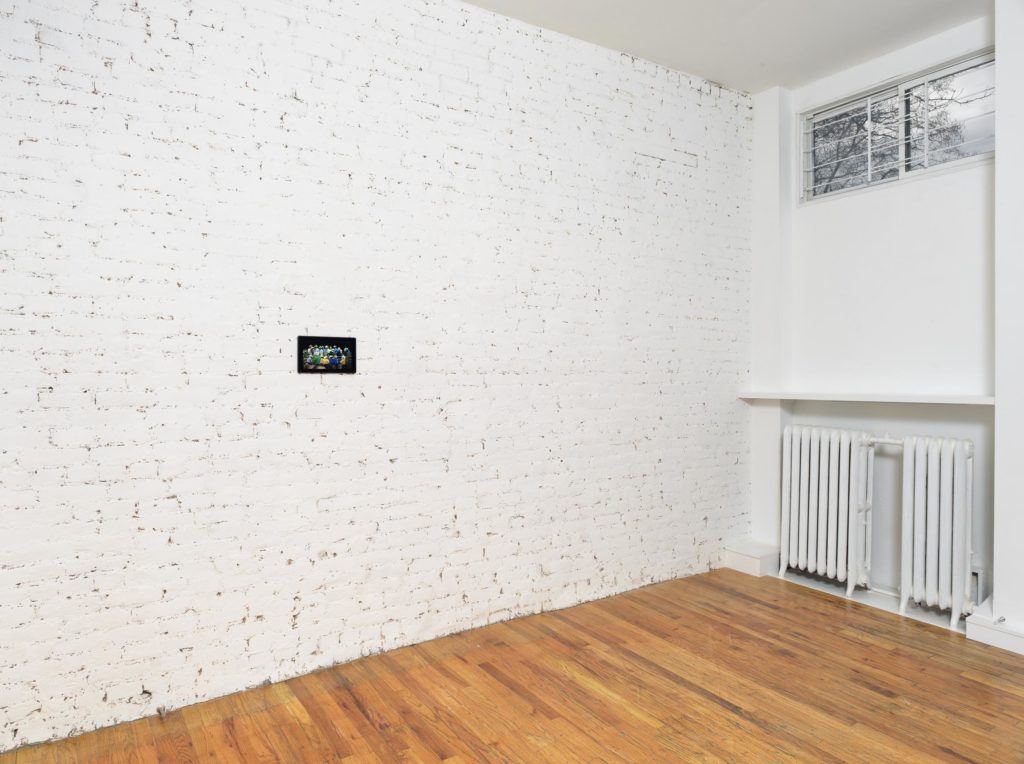
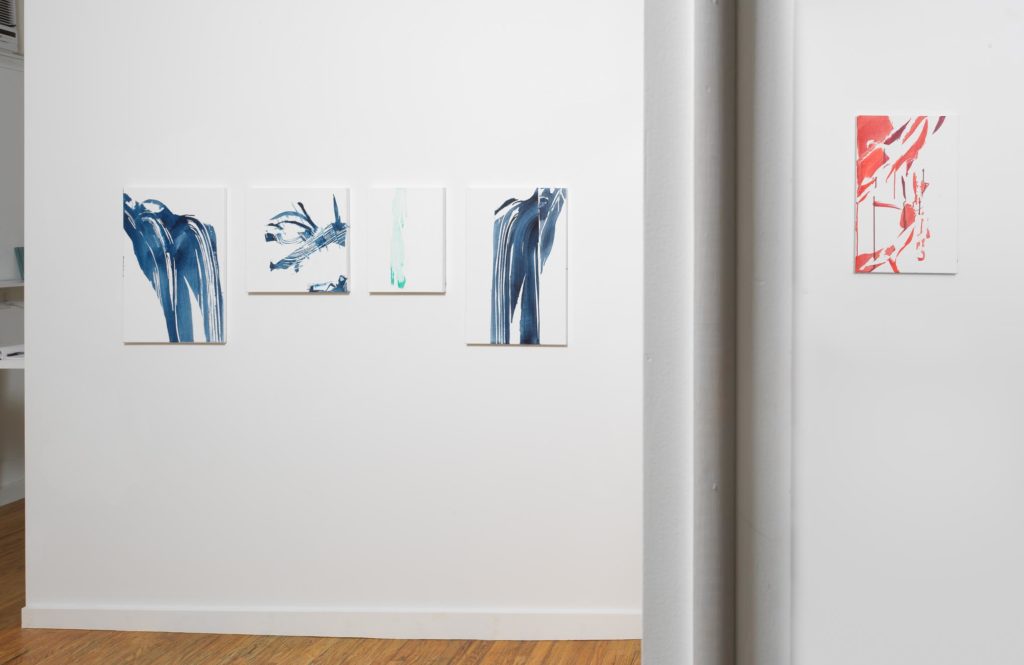
Happy New Year 3A Gallery. January 12 to February 4, 2018 – Opening: Friday January 12, 2018, 6-8p.m.
Wineke Gartz, Kate Harding, Trevor Shimizu, Tracy Dillon Timmins and Antoine Catala / Dan Graham.
Photos by Jeffrey Sturges.


Satoru Eguchi: Daymare Hangout. June 11 to July 9, 2017 – Opening: Sunday, June 11, 2017, 3-6p.m.
Dan Graham: I want to know why you do fountains.
Satoru Eguchi: why I do fountains?
DG: It reminds me a lot of some of Bruce Nauman’s work.
SE: He does fountains too, right?
DG: It’s semi-body art. In a way making fun maybe of traditional sculpture.
Peaceful, uneasy postures, flowing moves of soft black pencil lines, two look alike couple images, water energy that shoots up in the air that creates unemotional almost objects like portraits of me. Often situated in a room or in an open space the figures are interacting each other sometimes in harmony sometimes in conflict like my internal self.
I grew up near mountains and sea in Japan. After moving to New York in 1998, I often think about bringing nature elements home. It’s my child-like desire to possess miniature river, lake or mountains into my drawing.
When I made Fountain sculpture in Elizabeth Street Garden in 2014, I felt the garden was missing the water element. I am interested in re-creating nature element that you cannot grasp such as air, water, shadow into an object. My material for sculpture has been primarily paper. It was a challenge to make it work in an outdoor condition. It rained one day and the shape of fountain had changed.
Dan Graham, an artist and an astrologer, once asked me that if my fountain that relate to Bernini’s fountain in Rome or peeing figure in Antwerp. I think mine is more like peeing figure in Antwerp because it’s not monumental like Bernini’s. I feel my fountain also refers to human body because of the scale relative to one’s body, which makes me think of urination. Both my drawing and sculpture involve my own body and its relationship to the space. My body can be a sculpture.
Photos by Jeffrey Sturges.




Kate Harding: Uphill Downhill Conversation, (Sister): 3A Gallery Annex (4th floor). June 11 to July 9, 2017- Opening: Sunday, June 11, 2017, 3-6p.m.
“Uphill Downhill conversation, sister, that’s what I’m talking about when I’ve got nothing left to say en’ so much to express. Me and you, we’ve seen some things, and other things, well, we haven’t needed to see it to believe it.”
Harding lives and works between New York, rural Missouri and Los Angeles, and examines the specificity of site and the local to explore concepts of landscape, perception and inter-subjectivity. Seeing her practice as a continuation of purposeful ramblings in the woods that began in early childhood, Harding undertakes engagement with site as a resonant field and collaborator without hierarchy. Structured “field experiments” wherein her body becomes a tool of measure and site of projection are recorded and mined for information, to shape into discreet objects (paintings, diagrams, drawings, projections on/through varied surfaces) and environments. Interdisciplinary in material and approach, Harding’s background in garment design and construction often provides a metaphoric structure to her work, as does science, history, critical philosophy, folklore, and the colloquial phrase.
“Tell you what, you stay here and get the fire started. I’ll go see what I can do about your astigmatism. The stars don’t come out for just anybody and the conversation’s been on autopilot for years.”
“It’s more than just you an’ me, guys. You’re eyes glow in the dark when I shine light in ‘em. Kinda creepy funny sense of humor, you’ve got there, and I’m glad for the escort, though you’re feet are so much bigger than mine, I’ve got to wear boots.”
Uphill Downhill Conversation, (Sister) is a deepening within Harding’s work that expands to reveal presences previously supporting from the periphery. Engaging the non-human environment, including mules, birds, hills, water bodies, atmospheric conditions, remains central, while there is an additional erosion of verbal language that seeks to trick the divisive potential of coded speech. With the title’s mention of the traversal of felt terrain; a change in elevation or position, a ways to go and how it may feel in the getting there, or even in the consideration of another there, dialog and a correspondent familial relationship is parenthetically mentioned.
Photos by Jeffrey Sturges.



Willows and Palms: Josh Thorpe / Joe Beginner. Opening and Book Launch: Sunday, April 30, 3-6 p.m. 3A Gallery: April 30 to May 28, 2017
3A Gallery is pleased to present the work of Josh Thorpe, an itinerant Canadian artist, writer, experimental music composer, and rock musician.
Willows and Palms will be an informal presentation of several recent drawings and screenprints. The drawings are hasty and ham-fisted scribblings of nocturnal scenes in rich pastels, the screenprints more pristine representations of similar scenes in one or two strange colors.
“Some of Thorpe’s work reminds me of Saenredam’s paintings of empty churches,” Dan Graham said, “But it’s all about fantasy.”
As part of the exhibition, Thorpe will be introducing his latest piece of writing, Beginner’s Microbiome, published as alter- ego Joe Beginner. This semi- autobiographical novella is dedicated to the memory of New York writer Harry Mathews. Written in the form of a daily journal, the work is a tribute to the constant strangeness of daily life.
As described by Malcolm Sutton, fiction editor for Toronto’s BookThug press “Joe Beginner is a detective of the everyday, a genius of the senses.”
Photos by Jeffrey Sturges.


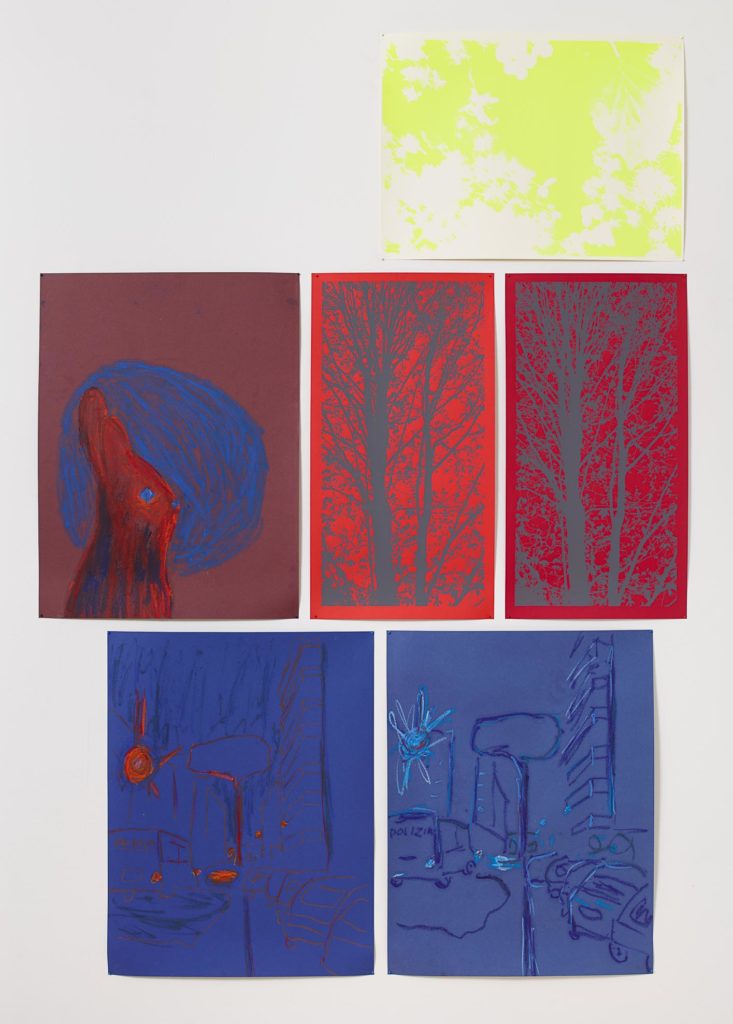
Into The Fold: Tracy Dillon Timmins. 3A Gallery Annex (4th floor) Opening: Sunday, April 30, 3-6 p.m. April 30 to May 28, 2017
Photos by Jeffrey Sturges.


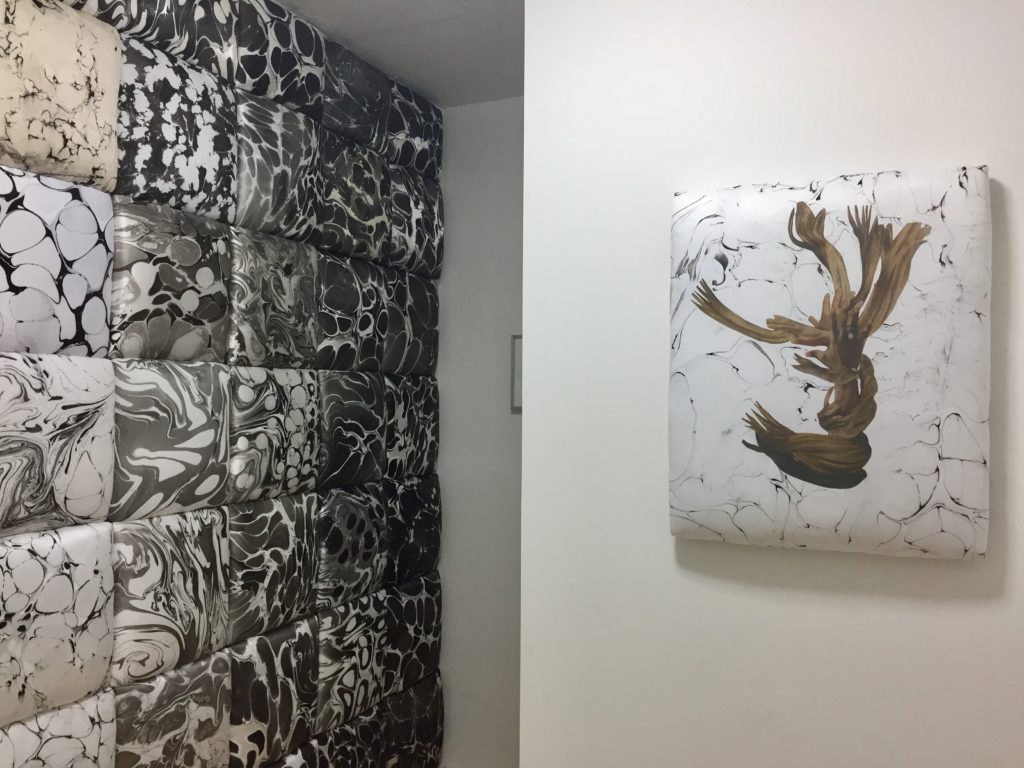


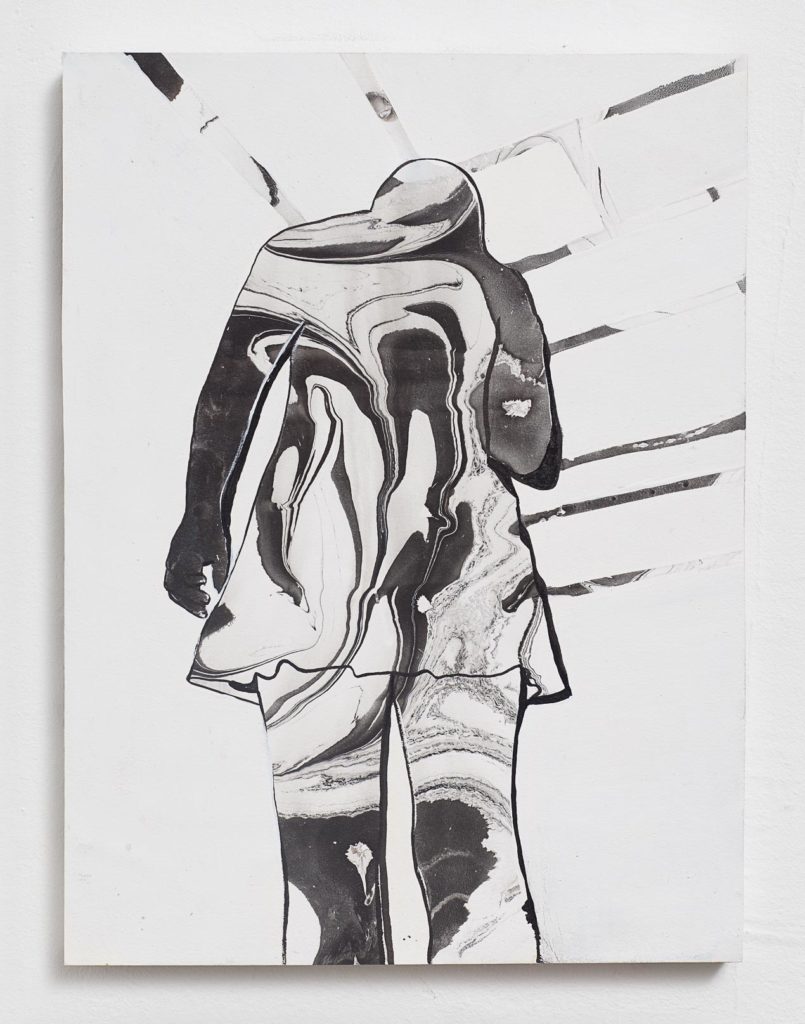
3A Gallery Film Festival
June 29th to August 28th 2016
Opening reception: June 29th 6-8pm

Ericka Beckman: Tension Building
Yoji Kondo: Parasol
Tom Morrill: Justice Coin Gold
Akiko Maruyama & Philippe Roy: Koropokkuru
Rebecca Naegele: Cyclops
Trevor Shimizu: Yawn
3A Gallery Film festival: Artists and works
Ericka Beckman: Tension Building
Film Type: Stop Motion Animation
Genres: Experimental
Runtime: 8 minutes, 30 seconds
Completion Date: 2014
Country of Origin: United States
Shooting Format: 16mm to HD (Prores 1080p, 24fps)
Tension Building is a composite of linked architectural spaces, some are real and some are models. I combine stop motion and live action filmmaking shot at the Harvard University Coliseum in Boston (1935) and the Municipal Stadium in Florence (1932), built in by Luigi Nervi. The motive for this film came from the question: How can I make a stadium an interactive platform for a game?
Credits:
Ericka Beckman- concept, camera, edit.
Richard Flanagan- Boston Symphony Orchestra, percussion.
Minute Man Marching Band
Funding in part by the LEF Foundation of New England 2007
Born in Hempstead, NY in 1951, Ericka Beckman is an artist and filmmaker, living and working in New York and Boston. Graduating from Cal Arts in 1976, she started to exhibit in the mid-1970s in such renowned independent spaces as The Kitchen, Artist’s Space and Franklin Furnace in New York. Since then her work has shown in museums in the U.S. and abroad: the Whitney Museum of American Art, New York; The MET, New York; Museum of Modern Art, New York; Museum of Contemporary Art, Los Angeles; The Hirshhorn Museum, Washington D.C.; The Walker Art Center, Minneapolis, MN; The Tate Modern, London, UK; Kunsthalle Bern, Switzerland; Le Centre de Georges Pompidou, Paris, France; The Museum Moderner Kunst, Vienna, Austria; Institute of Contemporary Art, London, UK; and Le Magasin, Grenoble, France. In addition, she has been included in four Biennials at the Whitney Museum of American Art, New York.
Yoji Kondo: Parasol
Film Type: Short Movie
Genres: love story
Runtime: 16 minutes 13 seconds
Completion Date: 2014
Country of Origin: Japan
Shooting Format: DV
Yoji Kondo’s work is often connected with /(slash); it gives a sign of division or conjunction. By adopting the media / that separates or connects a relationship in a different way from the ordinary use, he tries to allude a new relationship of the two unrelated ever. In this exhibition, he presents a video work titled PARASOL. This is a love story for all who had lost the human emotion. The / in this short movie is the parasol. It is not just a parasol but / as a media for connecting with a man and a woman indirectly. The indirectness by his / will convey our impossibility and possibility in contemporary society. www.yonderartsparty.com/YojiKondo.html
Tom Morrill: Justice Coin Gold
Film Type: Collage loop
Genres: Experimental
Runtime: 3minutes 55seconds
Completion Date: 2016
Country of Origin: United States
Shooting Format: HD Digital Video
Tom Morrill is an artist and composer from Florida. He lives and works in Brooklyn. He received his BFA from Rhode Island School of Design in 2008. Recent collaborations include the site-specific project No Notice, original music for The Law of Averages, a film by Lizzie Rose, and No Angle of Attack, a two-person show with Rebecca Naegele.
Akiko Maruyama & Philippe Roy: Koropokkuru
Film Type: Animation, Experimental, short
Genres: Experimental, Animation, Abstract
Runtime: 4 minutes 9 seconds
Completion Date: July 8,2015
Country of Origin: United States
Shooting Format: 16mm
A moving portrayal of an ineffable force that can be humanlike or embody itself within displayed objects. Inspired by concepts from the Koropokkuru folktale within Japanese Ainu culture, as well as The Invisible Man.
Akiko is a filmmaker and educator originally from Fukuoka, Japan. She graduated from Massachusetts College of Arts and Design with a Film/Video degree. She is currently teaching Film, Video and Animation in the NYC area.
Philippe is a digital artist and animator who studied at the School of the Museum of Fine Arts, Boston. Originally from South Florida, he now lives and works in the NYC area. Some of his digital work includes GIF art which is the source for projected imagery in this film.
Rebecca Naegele: Cyclops
Film Type: Surveillance, documentary
Genres: Experimental
Runtime: 5 minutes
Completion Date: 2015
Country of Origin: United States
Shooting Format: Digital
A remote-controlled video drone (toy helicopter) was flown within a confined area, crashing into each of the fence walls and concrete surfaces. Without an escape, the machine captures its own destruction.
Rebecca Naegele was born in 1990 in Queens, New York. She received a BFA in Sculpture from Washington University in St. Louis in 2012 and is a 2016-2017 Whitney Independent Study Program participant.
Trevor Shimizu: Yawn
Film Type: Digital Slideshow
Genres: New Age
Runtime: 1 minutes 5 seconds
Completion Date:
Country of Origin: Japan
Shooting Format: Screenshots
Trevor Shimizu was born March 30, 1978 of Japanese born Americanized parents. Like president Obama, he is from humble Hawaiian beginnings. Hawaii, a tourist destination in the mid 50’s, was popularized by the TV personality, Arthur Godfrey. Godfrey also introduced to the American public, the ukulele. American pop culture was fixated on Hawaii in the 50’s. Hawaii became an American clichè. Pop culture is very important to Shimizu. He is an aficionado of film and considered becoming a filmmaker or actor. Francis Ford Coppola, the Aries filmmaker had a big influence on San Francisco, where many films were made, and where Shimizu was introduced to media and performance. Here, he was introduced to the work of William Wegman, Ernie Kovaks, and Andy Kaufman.
He eventually found a very idealistic situation in New York at EAI. The great women artists, Carolee Schneemann, Shigeko Kubota, Dara Birnbaum, and Joan Jonas have been important in his development. He also worked as Dan Graham’s technician. His studio work is separate from his professional work, however.
Trevor Shimizu’s work has a conceptual, laconic humor. This element of humor is especially important in his work. Shimizu’s Japanese background informs his practice, relating to Japanese Manga and Anime. When he discovered he shared a birthday with Vincent Van Gogh and Francisco Goya, he wanted to paint. Trevor Shimizu’s goal in life is to have fun.
Günther Vogt: WUNDERLUST/WANDERKAMMER. March 4th to May 19th, 2016
WUNDERLUST/WANDERKAMMER book launch: March 4th, 6-8pm at 3A Gallery annex (4th floor)

“Günther Vogt is one of the most innovative 20th and 21st Century landscape architects. This book presents his dream panorama and research on Celtic Europe, in the form of a
modern cabinet of curiosity.” Dan Graham
Photos by Chris Cobb









Patrick Jackson and Asha Schechter: MUD OF MURK. January 23 – February 21, 2016
Organized by Trevor Shimizu
I’ve known Asha Schechter since about 1991 and Patrick Jackson since about 2001. The three of us moved to New York in 2002 and lived in a carriage house across from Prospect Park Southwest. They had bedrooms on the third floor and I lived at the base of the stairs, on the second floor. My rent was slightly less. It worked out well, because I was a nightclub photographer working late and had the living room to myself during the day. Patrick had a studio at the Marie Walsh Sharpe Foundation and he let me use a wall to work on drawings. That was really cool of him. Asha worked at Jane Magazine as a photo editor and hooked me up with several freelance photo jobs. Sometimes I would go with a beauty editor to 34th Street or Bryant Park and ask random women if they had a pedicure, a tattoo, or a belly button piercing. I’d photograph them if they had one of these beauty trends. Sometimes we asked random people if they could point out who they thought was hot. I also photographed blind dates: there was one at a Mets game, another between Talib Kwali and Santi White, before she was Santogold. One photo job allowed me to pay an entire month’s rent. Jane Magazine went bankrupt, but it was a good run.
I recently introduced Asha and Patrick to Mieko, suggesting that they do a two-person show at 3A Gallery. Maybe this is a small way of returning their favors, but we’ll see how it goes. I don’t know too much about what they’re making for the show, but Asha has told me his video involves a barista championship, which sounds pretty incredible. I can relate since I was once a barista in Los Angeles, where both Patrick and Asha currently live and work. I often served coffee to Ryan Gosling.
Patrick emailed me this paragraph about his work: “I began these pieces by sitting at a large tray of clay and sculpting what came to mind. These final wall reliefs are casts of the originals, made of a reddish-brown plasticine often used in prototyping. So far, I’ve made twelve of these, and as they’ve grown in number I’ve come to see them as my subconscious iconography.”

Patrick Jackson
Untitled
2015
plasticine, polyurethane, plaster, epoxy
28 x 37 x 7 inches
Edition 1 of 2 + 1 AP
This untitled wall relief is part of a new series of work, based off of drawings Patrick Jackson made over the past 15 years. He looks through old sketchbooks for repeating images, and takes from them to develop his own personal iconography. The imagery varies, but often contains body parts: mouth, ear, hands, fingers, neck, teeth, tongue, etc. Each relief is sculpted using a soft clay called WED, which stands for Walt E. Disney (Disney imaginers came up with the recipe for this particularly malleable clay). Molds are taken of the original works, and the final pieces are cast in a hard pink plasticine, a type used to create design prototypes.
Asha Schechter
Coffee Scene
HD Video 13:57. 2016
“Coffee Scene” juxtaposes footage of Charles Babinksi in the semifinals of the 2015 US Barista Championship with footage of Slovakian 3D modeler Milos Jakubec making a 3D model of Charles’ winning cappuccino. This model is available for free download at:
http://www.turbosquid.com/3d-models/coffee-scene-max-free/993622
Charles went on to win the US championship and placed 2nd in the World Barista Championship.



Paul McMahon: Me. November 5 – December 13, 2015
Paul McMahon is a somewhat mythic ‘survivor’ from the ‘Pictures Art’ generation. As co-creator of the art-world rock group, “Daily Life”, McMahon created a persona as a charismatic songwriter/performer/artist. His best-known song is “Rock ‘N Roll’ Therapist’. Both his art and his rock music have a loveable, whimsical, and goofy humor.
The theme of McMahon’s 3A Gallery show is “Me”, consisting of self-portrait drawings of the artist. As a post-immature, older ‘Dad’-figure, one possibility is that McMahon, who now identifies himself with ‘60’s ‘hippie’-era culture is making a comment on the general trend of the ‘70’s toward ‘Meism’.
– Dan Graham
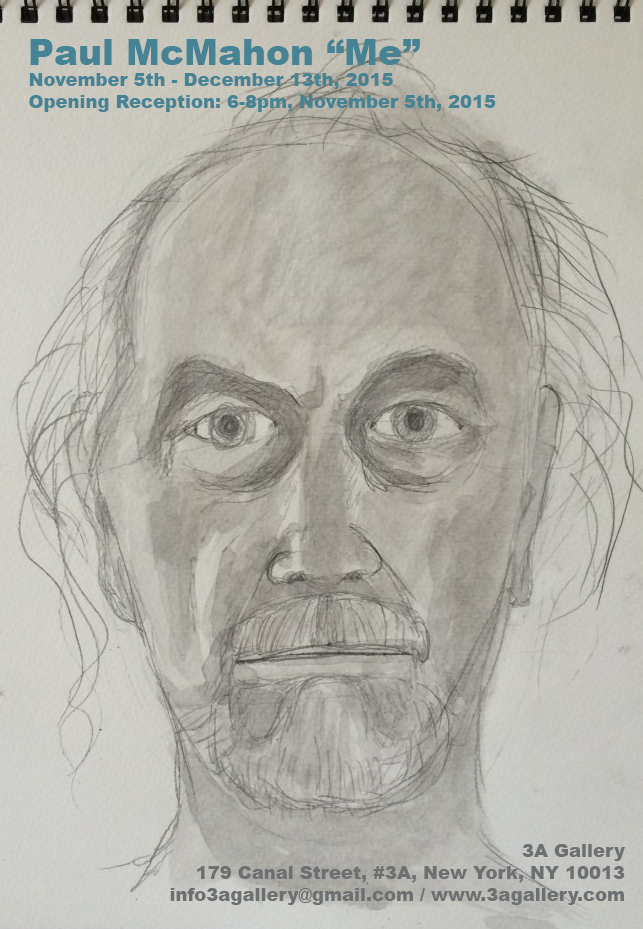

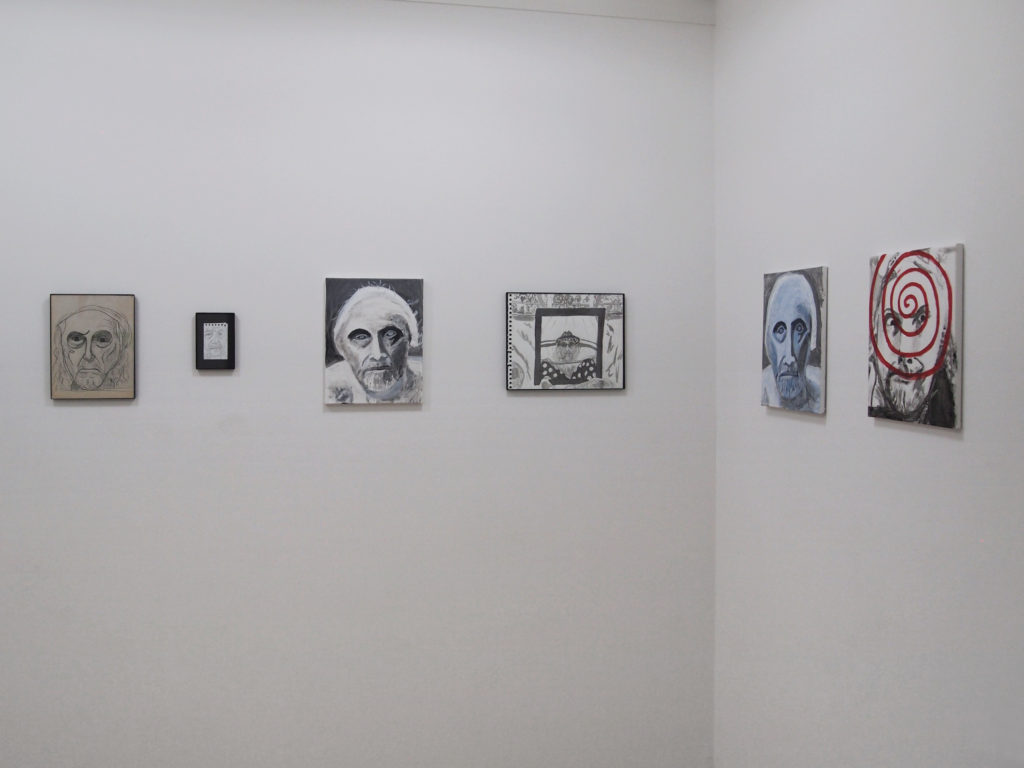

Jef Geys: Some Paintings From Belgium. March 26th, 2015–July 23rd, 2015


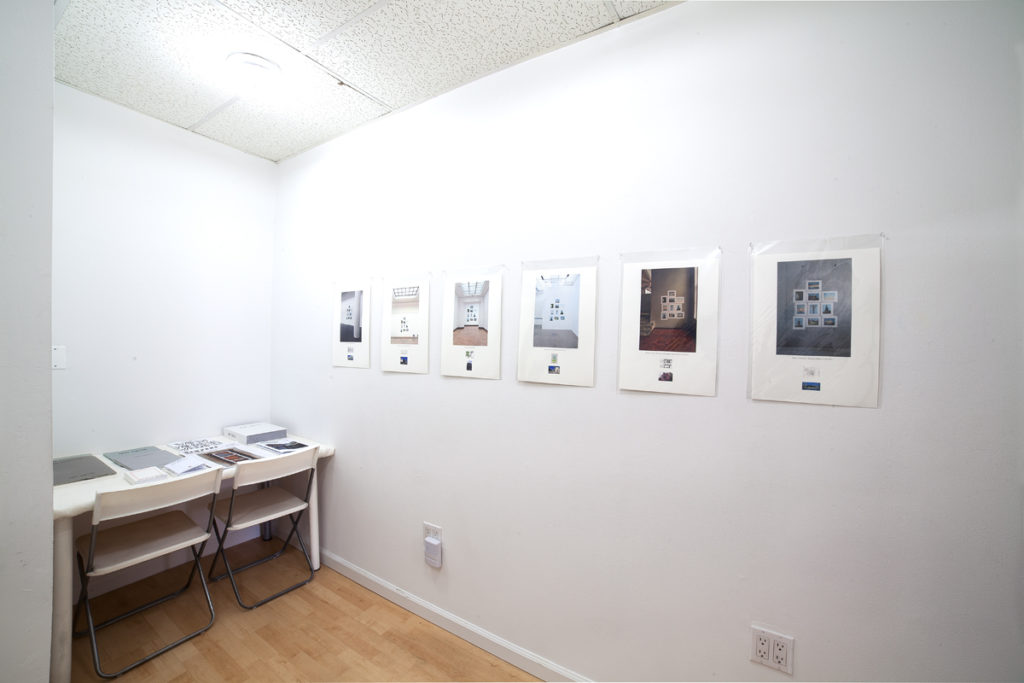


Dan Graham Collection. November 19th, 2014–February 14th, 2015




Betty Beaumont: THAT OBSCURE OBJECT OF DESIRE. September 8th–October 11th, 2014
3A Gallery is pleased to announce a solo exhibition of New York based artist Betty Beaumont.
Beaumont has for years produced thoughtful and provocative work in a variety of media including photography, installations, public interventions and new media. Her work challenges global social awareness, as well as socioeconomic and ecological practices. Beaumont has investigated such issues as energy and species diversity and is also involved with solution-based sustainability strategies, which reflect contemporary, historic and cultural perspectives and environmental and social conditions.
Beaumont’s exhibition That Obscure Object Of Desire takes the idea of the object of desire and all of the myths that surround it and puts into three works ideas which deconstruct the fetishized icons of beauty and the branding of identity.
With the tools of deconstruction and notions of sexuality and representation, Beaumont uses three elements. First, the language of narcissism; second, questioning the idea of beauty in a crushed shopping bag first presented in two dimensions as a photograph, then as a moving object on a pedestal; and finally, the motor, which is simultaneously functional and a symbol of the machine behind advertising, branding and the loss of autonomy and identity.
The photograph Crushed 001 (2012) takes the three-dimensional bag out of reality and puts it in a frame, flattening the image of the bag (the photographed object), becoming the symbol of the symbol, that which we desire to possess. The bag remains pristine, inviolate, removed from our ability to touch or grasp.
The sculpture Untitled (Crushed, yellow with black) #332 (2014) presents the bag on a moving pedestal heightening the allure of the artifact under glass. The way it is presented as sculpture is enhanced by placing it in the vitrine, removed from the individual. The brand or the logo is hidden the way the seductiveness is hidden. Yet there is still a recognition. The sculpture is understood by experiencing both front and back of the work. The sound of the motor turning the bag on the pedestal suggests the sound of voracious consumption. The sound lures the viewer to view the motor, which is also encased in glass. Although the bag has been crushed it is not detritus. We want to own, touch or posses it. In its cast off state it is fetishized as a precious object. The recent implosion of the economy crushed the bag, transforming it into a sculpture that has architectural references, no longer retaining its original use. The on-going Untitled (Crushed) works are part of a project begun in 2008 with the Great Recession.
I’d Rather Be (1991) is a full-length mirror work that borrows a quote from Donna Haraway’s Cyborg Manifesto “I’d rather be a cyborg than a goddess” and prints it horizontally near the top of the mirror. When one looks into the mirror while contemplating beauty of the self, one is struck by a statement across one’s body that poses the question, What forms the lens you see yourself through? This deconstructive comment cuts the myth of beauty in two.
The sculpture Untitled (Crushed, yellow with black) is indeed on a pedestal like an object of desire. That Obscure Object Of Desire.
Betty Beaumont has received numerous grants and awards including the Distinguished Alumni Award from the University of California at Berkeley, Creative Capital Foundation grants, National Endowment for the Arts fellowships and grants, New York State Council on the Arts fellowships and Pollock-Krasner Foundation grants. She has shown at museums and galleries around the world including The Bibliotheca Alexandrina in Alexandria, Egypt, Whitney Museum of Art, MoMA P.S. 1, Queens Museum, Carriage Trade Gallery (NYC), American Fine Art (NYC), Damon Brandt Gallery (NYC), Hudson River Museum (Yonkers, NY), Katonah Museum (Katonah, NY), National Museum of Modern Art (Kyoto and Tokyo, Japan), Museum Het Domein (Sittard, Netherlands), Biblioteca Nacional Jose Marti (Havana, Cuba), Galerie Engstrom (Stockholm, Sweden), Bea Voigt Galerie (Munich, Germany), Stalinova Pomniku, Letenske Plani (Prague, Czech Republic), Ota Gallery (Tokyo, Japan) and the Richard Demarco Gallery (Edinburgh, Scotland). Texts on Beaumont’s work have been written about by a number of art historians and critics including Nancy Princenthal, Jeffrey Kastner, Brian Wallis, Gary Indiana, Martin Kemp, Patricia C. Philliips, Kay Larson, Michael Kimmelman, Amanda Boetzkes, Barbara Metilsky, Sara Selwood, Kim Levin, Amy Gamerman, Marilu Knode, Amber Vilas, Peter Scott and Robert Stefanotti. Beaumont has held academic appointments at the University of California at Berkeley, SUNY Purchase, The School of the Art Institute of Chicago, New York University and Columbia University in New York City.

We Are all Cats at Karma International. 18 April–23 May 2015
Trevor Shimizu, Shimon Minamikawa, Frank Stürmer, Wineke Gartz, Dan Graham, Paul Mcmahon, Daniel Brant and Mieko Meguro.
karma international: Hänggerstrasse 40, CH 8037 Zürich, Switzerland

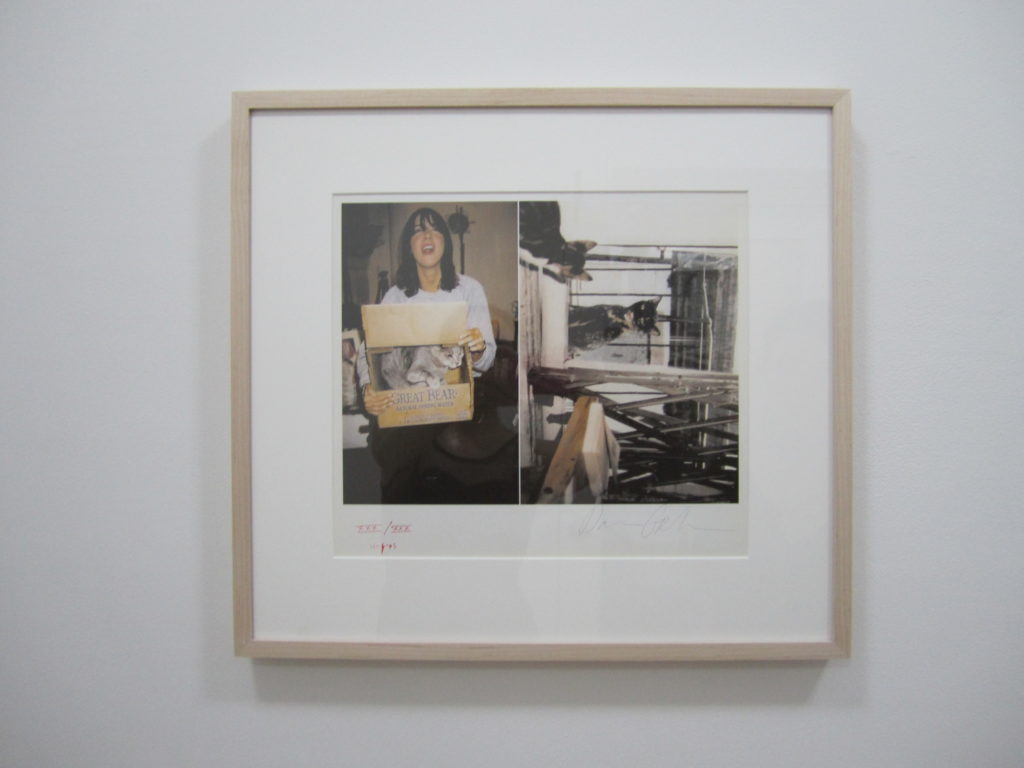
Aura Rosenberg and John Miller: The Angel of History. September 19-October 11 2014. Opening Reception: September 19, 6-8pm
A Klee painting named “Angelus Novus” shows an angel looking as though it is about to move away from something it is fixedly contemplating. Its eyes are staring, its mouth is open, its wings are spread. This is how one pictures the angel of history. Its face is turned toward the past. Where we perceive a chain of events, it sees one single catastrophe, which keeps piling wreckage and hurls it in front of its feet. The angel would like to stay, awaken the dead, and make whole what has been smashed. But a storm is blowing in from Paradise; it has got caught in its wings with such violence that the angel can no longer close them. The storm irresistibly propels it into the future to which its back is turned, while the pile of debris before it grows skyward. This storm is what we call progress.
The true picture of the past flits by. The past can be seized only as an image which flashes up at the instant when it can be recognized and is never seen again.
–Walter Benjamin, Thesis on the Philosophy of History
The angel of history is the inspiration for Aura Rosenberg’s film. Compressed into five minutes, this film animates the ruin and progress of history, starting with formation of planets from gas clouds through to the present. The pile, culled from an online pictorial archive, depicts Benjamin’s single catastrophe. A flash of original paradise interrupts the cataclysmic momentum and reminds the viewer of the dialectic of history in which the past can be recalled only in relation to the demands of the present.
The installation will include Symmetrical Arrangement by John Miller.




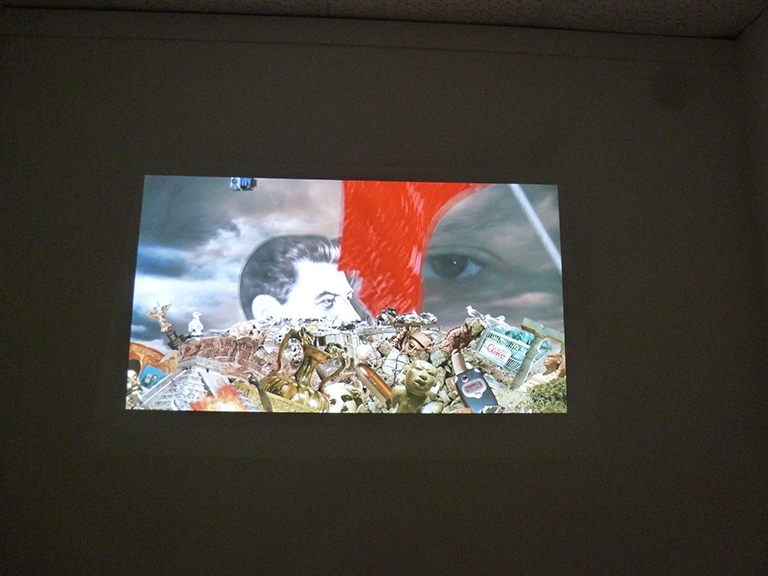


Justin Lieberman & Devon Costello: Mega Japan. June 5th to July 5th, 2014
Fuji Photo Film Co., Ltd. was established in 1934 with the aim of being the first Japanese producer of photographic films. Over the following years, the company produced photographic, motion picture, and X-ray film. In the 1940s, Fuji Photo entered the optical glasses, lens, and equipment markets. After the Second World War, Fuji Photo diversified, penetrating the medical, printing, electronic imaging and magnetic materials fields. In 1962, Fuji Photo and UK-based Rank Xerox Limited (now Xerox Limited) launched Fuji Xerox Co., Ltd. through a joint venture. From the mid-1950s, Fuji Photo accelerated the establishment of overseas sales bases. In the 1980s, Fuji Photo expanded its production and other bases overseas, stepping up the scope of its globalized business model. Meanwhile, Fuji Photo developed digital technologies.
Like its rival Eastman Kodak that dominated in the US, Fuji Photo enjoyed a longtime near-monopoly on camera film in Japan. By becoming one of the title sponsors of the 1984 Los Angeles Olympics (an opportunity that Kodak passed on), offering cheaper camera film, and establishing a film factory in the US, Fuji gained considerable market share in the states while Kodak had little success in penetrating Japan. In May 1995, Kodak filed a petition with the US Commerce Department under section 301 of the Commerce Act, arguing that its poor performance in the Japanese market was a direct result of unfair practices adopted by Fuji. The complaint was lodged by the US with the World Trade Organization. On January 30, 1998, the WTO announced a sweeping rejection of Kodak’s complaints about the film market in Japan.
The beginning of the new millennium witnessed the rapid spread of digital technology in cameras. Demand for photographic films showed a sudden plummet in line with the growing popularity of digital cameras. In response, Fuji Photo implemented management reforms aimed at effecting drastic transformation of its business structures. Even as early as the 1980s, the company had foreseen the switch from film to digital, so it developed a three-pronged strategy: to squeeze as much money out of the film business as possible, to prepare for the switch to digital, and to develop new business lines. While both film manufacturers recognized this fundamental change, Fuji Photo adapted to this shift much more successfully than Eastman Kodak (which filed for bankruptcy in 2012). Fuji Photo’s diversification efforts also succeeded while Kodak’s had failed; furthermore Kodak built up a large but barely profitable digital camera business that was undone quickly by smartphone cameras. In 2006, Fujifilm announced plans to establish a holding company, Fujifilm Holdings Corp., of which Fujifilm and Fuji Xerox are subsidiaries. A representative of the company reconfirmed its commitment to film, which accounts for 3% of sales.
Hokusai’s date of birth is not known for certain, but is often said to be the 23rd day of the 9th month of the 10th year of the HÅreki era (in the old calendar, October 31, 1760) to an artisan family, in the Katsushika district of Edo, Japan. His childhood name was TokitarÅ. It is believed his father was the mirror-maker Nakajima Ise, who produced mirrors for the shogun. His father never made Hokusai an heir, so it is possible that his mother was a concubine. Hokusai began painting around the age of six, possibly learning the art from his father, whose work on mirrors also included the painting of designs around mirrors.
Hokusai was known by at least 30 names during his lifetime. Although the use of multiple names was a common practice of Japanese artists of the time, the amount of names he used far exceeds that of any other major Japanese artist. Hokusai’s name changes were so frequent and so often related to changes in his artistic production or style that they are useful in breaking his lifetime up into periods.
At the age of 12, he was sent by his father to work in a bookshop and lending library, a popular type of institution in Japanese cities where reading books made from wood-cut blocks was a popular form of entertainment for the middle and upper classes. At 14, he became an apprentice to a wood-carver, where he worked until the age of 18 before being accepted into the studio of Katsukawa ShunshÅ. ShunshÅ was an artist of ukiyo-e (a style of wood block prints and paintings that Hokusai would master) and head of the so-called Katsukawa school. Ukiyo-e, as practiced by artists like ShunshÅ, focused on images of the courtesans and Kabuki actors popular in Japan’s cities at the time.
After a year, Hokusais name changed for the first time, when he was dubbed ShunrÅ by his master. It was under this name that he published his first prints in 1779, a series of pictures of Kabuki actors. During the decade he worked in ShunshÅ’s studio, Hokusai married his first wife, about whom very little is known except that she died in the early 1790s. He married again in 1797, although this second wife also died after a short time. He fathered two sons and three daughters with these two wives, and his youngest daughter Sakae, also known as ÅŒi, eventually became an artist.
Upon the death of ShunshÅ in 1793, Hokusai began exploring other styles of art, including European styles he was exposed to through French and Dutch copper engravings he was able to acquire. He was soon expelled from the Katsukawa school by ShunkÅ, the chief disciple of ShunshÅ, possibly due to studies at the rival KanÅ school. This event was, in his own words, inspirational: What really motivated the development of my artistic style was the embarrassment I suffered at ShunkÅ’s hands.
Hokusai also changed the subjects of his works, moving away from the images of courtesans and actors that were the traditional subjects of ukiyo-e. Instead, his work became focused on landscapes and images of the daily life of Japanese people from a variety of social levels. This shift was a breakthrough in ukiyo-e and in Hokusai’s career. Fireworks at RyÅgoku Bridge (1790) dates from this period of Hokusai’s life.
Devon Costello and Justin Lieberman have installed an exhibition referencing the cultural legacy of Japan. Both born in the US, Costello and Lieberman use cameras, hats, ceramics, and paint to synthesize a Japanese American experience. Although neither Costello nor Lieberman have visited Japan, the works on view in this exhibition generate questions about cultural fetishism and the tourist’s perspective or interpretation of a place from an appropriated history.









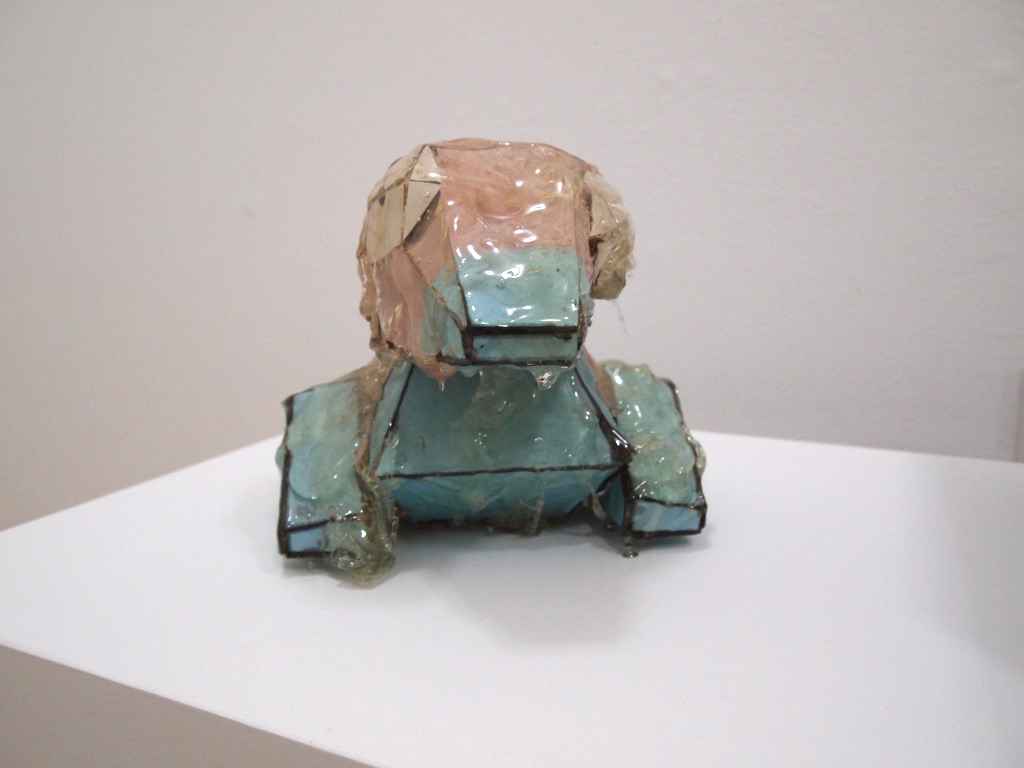



Dan Graham, Marc Joseph Berg, George Skelcher, Isabel Schneider, Mieko Meguro: Food Show 2. March 21st to April 18th, 2014.
Understanding food is a function of intelligence.




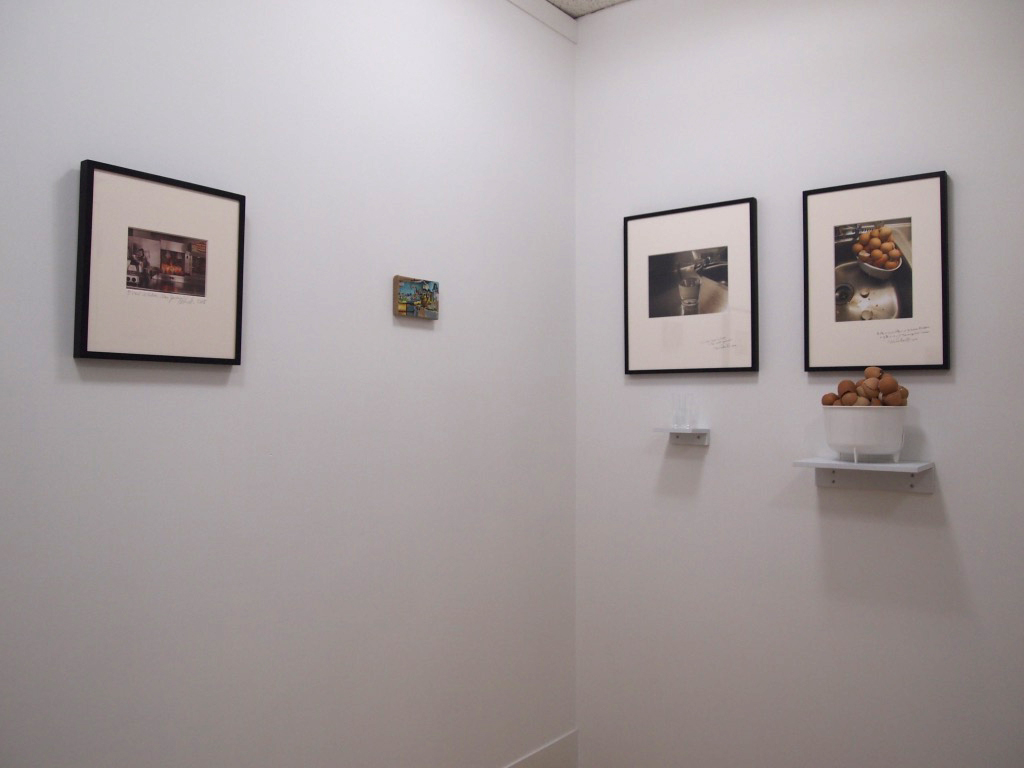






Josh Thorpe: A Dog at Sea. May 31st–June 28th 2013. Opening Reception Friday, May 31, 5–8 pm
Poems about wayward dogs, loose figurations in low light, a large wall painting about a Roman toga. Maybe some ukulele
or electric guitar. Doodles, sketches, funny faces, nocturnes
Josh Thorpe makes installations, paintings, drawings, music, and texts. He teaches writing at University of Toronto and works at a heritage architecture firm called ERA. Recent work includes exhibitions or special projects at Toronto Sculpture Garden, Museum of Contemporary Canadian Art, Plug In ICA, Printed Matter, and David Roberts Art Foundation, UK. Articles and interviews have been published by Canadian Art, Border Crossings, and the Power Plant, and in 2009 Art Metropole published Thorpe’s book, Dan Graham Pavilions: A Guide. In 2011, Thorpe was a finalist in the Toronto Friends of the Visual Arts Artist Award and was elected to the Sobey Art Award Ontario Long List.

Galleria Massimo Minini’s 40th Anniversary Show: The Postcard Days. May 10th to May 24th, 2013. Opening reception Friday, May 10th, 6-9:30pm
Galleria Massimo Minini “The Postcard Days” Dan Graham
Massimo Minini, one of Europ’s most admired art dealers has been operating his gallery for 40 years and has become a collector, not only collecting fine art, but postcards. It’s not old-fashioned to collect postcards. 60’s artists had this passion, sometimes making art out of postcards, one example being On Kawara’s postcard piece: I woke up at… Minini, along with the 60’s generation of artists, collect and display in their private homes artworks of friends and postcards, postcards are cherished as both a kitsch-like art-form and an emblem of shared friendships. An exhibition of Minini’s personal postcard collection will be featured from Friday, May 10th to May 24th at 3A Gallery
Galleria Massimo Minini history; http://www.galleriaminini.it/contacts/
THE POSTCARD DAYS by Massimo Minini
Once upon a time the world was different, maybe no worse, maybe no better, who’s to say.
In any case that world was there, just waiting to be seen even by mere mortals like ourselves, tourists driven by curiosity: not dauntless
African explorers, just earnest pilgrims in our humble red Fiat 500 Topolinos, Renault Dauphines, and Ford Anglias.
Wearing our sailor suits as Susanna Agnelli would say, we roamed through Italy, then Europe and America, which to us mainly meant New York.
Some truly adventurous souls even made it as far as Los Angeles.
We were travelling in the days before highways, before cell phones, calling home from pay phones that took tokens: in Italy, these were made
of copper, with two grooves on one side and one groove on the other.
Back then you could count on fog in winter, fireflies in May, and swallows till the beginning of August.
The world was quite a discovery; though it had been discovered long ago, we were seeing it for the first time and just had to let our family
and friends in on the joy.
So how did we tell our loved ones all about it? With postcards, of course!
Colorful little pictures of vacationland, beaches lined with umbrellas, mountains cloaked in snow, a lady on skis in Cortina doing a stem
Christiana, the Swiss Alps full of cows, Tyroleans playing their long horns, Munichers swigging tankards of beer, Scottish men with hairy
legs and red cheeks puffing bagpipes, airplanes flying the skies, ships sailing the seas, Emilio Comici climbing mountains, the Lake Garda
of every German’s dreams…
Artists were no exception, and like maiden aunts, would send us pictures of newborn babies, absurd cards from some kitschy restaurant,
overflowing soccer stadiums, very avant-garde postcards with very old-guard subjects.
Some artists not encumbered by modesty would send their own portraits or one of their works as a memento, lest we need reminding.
Then came the Internet, the web, Facebook, Twitter, and everything changed. The world is different now, maybe no worse, maybe no better,
but the postcards have stopped coming.
And so we’ve gathered together those cherished old pictures and put them in a little book for posterity, presenting them in May 2013 at
the New York gallery of our friend Mieko Meguro: one of those old-fashioned people who every so often will still fire off a postcard…
IL TEMPO DELLE CARTOLINE scritturata Da Massimo Minini
C’era una volta un mondo diverso, non peggio del nostro, non meglio, chissà .
Comunque c’era, quel mondo, ed era l bello e pronto per essere visto anche da noi comuni mortali, turisti per curiosita , non eroici
pionieri dell’Africa, ma onesti viaggiatori sulle topolino amaranto, sulle Dauphine Renault, sull’Anglia, sulla Cinquecento Fiat.
Vestivamo alla marinara e giravamo qua e l per l’Italia, poi l’Europa e l’America che, per noi era principalmente New York.
Qualche avventuroso si spingeva addirittura a Los Angeles.
Viaggiavamo prima della costruzione delle autostrade, prima dei cellulari, telefonavamo dalle cabine a gettoni che
in Italia erano di rame con due scanalature da una parte ed una sola dall’altra.
Allora d’inverno c’era la nebbia, a Maggio le lucciole e le rondini fino ai primi d’Agosto.
Il mondo era una scoperta, anche se era gia stato scoperto da tempo, ma noi lo
vedevamo per la prima volta e non potevamo non comunicare questa gioia ad amici e parenti.
Come potevamo far parte ai nostri cari di tutto questo? Ma con le cartoline!
Piccole colorate immagini di vacanza, spiagge con gli ombrelloni, montagne con la neve, una sciatrice a Cortina che fa lo Sten
Christiania, le Alpi svizzere con le mucche, Tirolesi che suonano il grande corno, Tedeschi a Monaco che bevono birra a boccali,
Scozzesi con le gambe pelose e gote gonfie mentre soffiano nelle cornamuse, aeroplani in volo, navi che solcano i mari, Emilio Comici
che scala i monti, il lago di Garda sogno dei tedeschi…
Gli artisti non facevano eccezione, e come vecchie zie, ci mandavano foto delle bambine appena nate, improbabili cartoline
di un ristorante kitsch, stadi di calcio strapieni di folla, cartoline molto d’avanguardia con soggetti molto di retroguardia.
Qualche artista, senza modestia, ci mandava il proprio ritratto o una propria
opera a mo’ di memento, non si sa mai, magari ce ne dimenticassimo.
Poi a¨ arrivato internet, il web, Facebook, Twitter, e tutto a¨ cambiato. Oggi il mondo a¨ diverso, non peggio, non meglio, ma
cartoline non ne arrivano pia.
Cosa abbiamo raccolto le vecchie care immagini e le abbiamo messe in un piccolo libro, a futura memoria, presentate a New York
nel Maggio 2013, nella galleria di Mieko Meguro, nostra amica, una all’antica, che ogni tanto manda – ancora- cartoline….

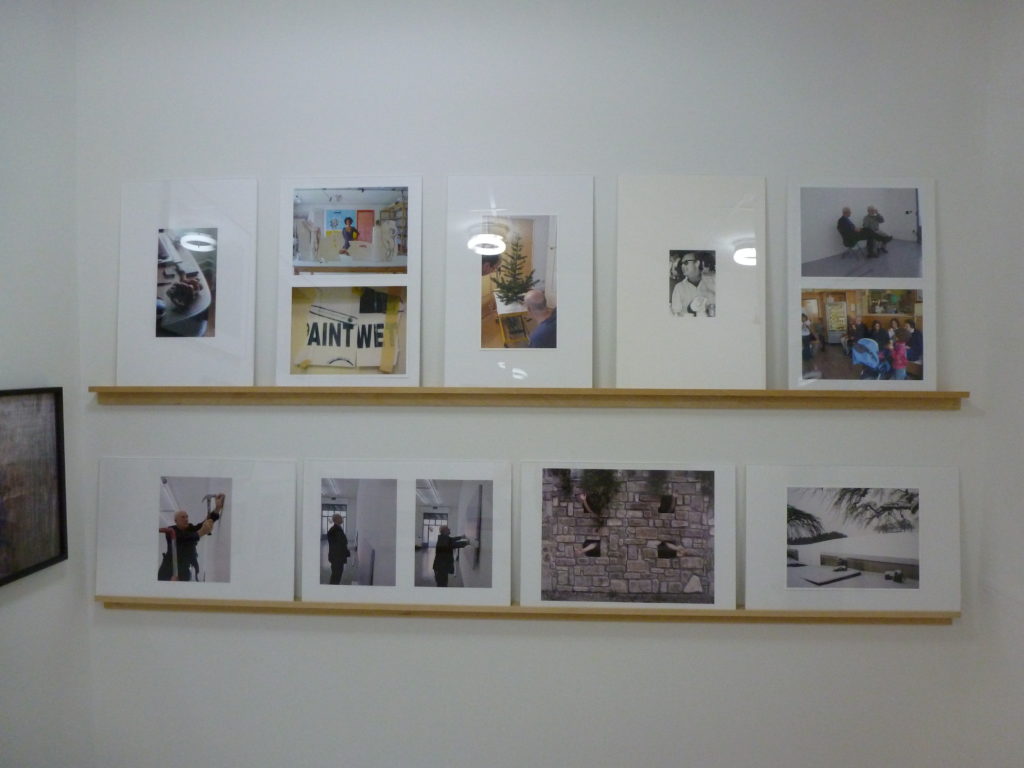
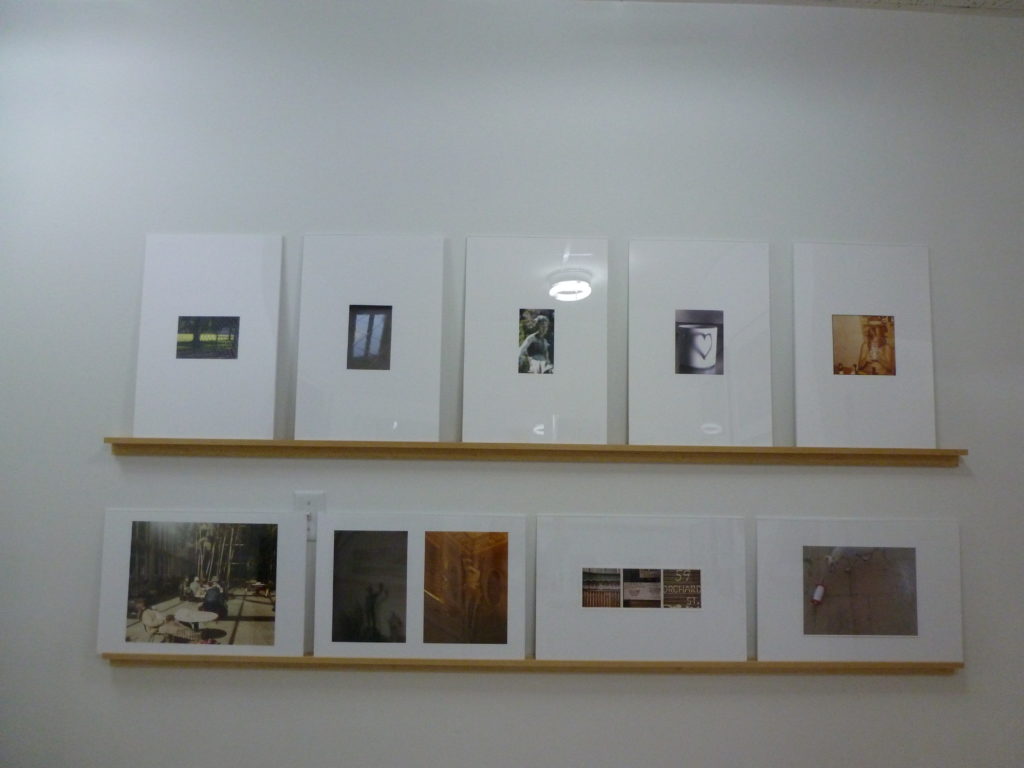
Wineke Gartz: American Pain. March 22nd to April 19th, 2013. Opening reception Friday, March 22nd, 6-8pm
Wineke Gartz, an Amsterdam based artist, will show at 3A Gallery from March 22nd until April 19th, in an exhibition titled American Pain(ting). This work combines video, drawings and collage with sound mixes. Gartz’s work was last shown in New York at 303 Gallery in 2009 in a group exhibition curated by the artist, Dan Graham. American Pain involves an investigation of the American dream landscape, linking historical 19th Century American luminist landscape painting (such as Thomas Cole) to the present-day Disneyotic Fantasyland in the suburban arcadia setting of the Native American operated Mohegan Sun casino-entertainment complex.
The casino’s theme-park-like setting can be viewed as a temple linking America’s Native American past to the promised future dreams of monetary success and a luxurious glamour life style for visitors who flock to Mohigan Sun Country by bus from Chinatown. Gartz visualizes Mohegan Sun’s interior architecture as a Kafkaesque Nature Theater.

Susan Grayson: Sequences–Portraits From The 70s, etc. Opening reception Friday, February 15th, 6-8pm
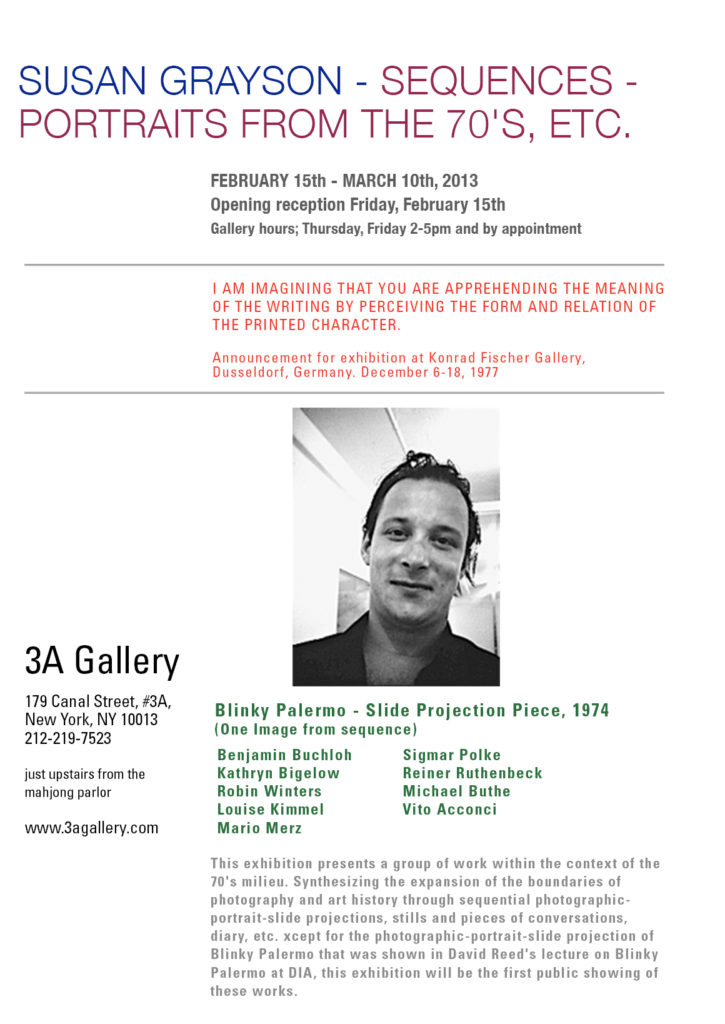
Nancy Haynes: THE PAINTING UNDRESSED. Opening reception: Wednesday, December 12, 2012 6-8pm

Peter Scott: Pardon Our Disappearance, Part One. Wednesday 12, September – Friday 19th, October. Opening reception Wednesday 12, September 6-8pm
While photography is normally tasked with capturing its subject, the images in the photographically derived paintings in Pardon Our Disappearance, Part One seem to perpetually come and go. Painted on the reverse of raw cotton, the front side of the canvas appears blank. While a closer look gradually reveals a face, the residual image resists a fixed definition.
Conveying the relationship between aspiration and societal standards of beauty, these portraits of makeovers and look-a-likes employ a perceptual ambiguity which slows down the process of looking, removing some of the intentionality of the original images as they’re rendered more speculative.
In the second part of the exhibition, at Sometimes (works of art), the makeover process is considered in the context of urbanism, with photographs that reveal the significance of lifestyle culture in the reshaping of both the perception and reality of the built environment.
Peter Scott is an artist, writer, curator, and director of the non-profit gallery carriage trade. His work has been exhibited in the U.S. and Europe, including one-person exhibitions in the U.S., U.K., Holland, France, and Belgium. His writing has appeared in Artscribe, ArtUS, Zing Magazine, artnet, The Architect’s Newspaper, and Art Monthly as well as several exhibition catalogues. His projects have been featured in various publications including Artscribe, artforum.com, The New York Times, The New Yorker, The New York Observer, Time Magazine, Huffington Post, ArtCards, and artnet magazine.
Pardon Our Disappearance, Part Two will take place at Sometimes (works of art), 83 Canal Street 610, September 19-October 30. Opening September 19 at 6pm with a 7:15 pm performance by David Watson and Matthew Ostrowski.

Kurt Finsten: Paintings. August 2-26, 2012. Opening reception August 2nd, 6-8pm
The Poppies Blooming all around My Herbert loves to see, Some pearly white, some dark as night, Some red as cramasie;
He loves their colours fresh and fineAs fair as fair may be, But little does my darling know How good they are to me.
(Sara Coleridge: from “Poppies” 1834)
Kurt Finsten b. 1943. Artist. Director of Krabbesholm Højskole. Living in Western Jutland, a remote part of Denmark. http://www.krabbesholm.dk

JoJo Li: ARTIST ASLEEP, PILLOW AT WORK. June 8–July 22, 2012. Opening reception: June 8, 6-8pm.

Fine Art Photography. May 5th 2012- May 20th 2012
3A Gallery is glad to announce the collaboration with Galeria Massimo Minini.
Galleria Massimo Minini and 3A Gallery collaborate to present the exhibition Fine Art Photography,
inspired by Vision #5
http://www.leftmatrix.com/vision5.html
The artists involved in both Vision #5 and Fine Art Photography are known for working in mediums other than photography, mostly painting and sculpture.
The works are not just studies, but give visual clues into the artists; conceptual processes.
Photography which is a universal medium nowadays but that for its immediacy can give us an immediate glimpse on the artist’s life and perception.
Francesco Clemente, Dan Graham, Sol LeWitt, Luce Wilson, Robert Barry, Lawrence Weiner, Peter Halley, Ghada Amer, Reza Farkhondeh, Paul P., Haim Steinbach, Gwen Smith, Betty Woodman, George Woodman,Gianfranco Gorgoni, Francesco Simeti, Thea Westreich Wagner, Lucio Pozzi, Gianni Pettena, Pamela Giaroli,
Massimo Minini, Sienna Shields, Chuck Close, Mieko Meguro.
This show will coincide with the participation of Galleria Massimo Minini at the Frieze Art Fair in New York, May 4th -7th 2012. This is a one night event for friendship. Galleria Massimo Minini welcomes America and their American friends.
Let’s get together for Drinks May 5th, 6-9 pm at 3A Gallery, 179 Canal Street, 3rd floor.The show continues until May 20th 2012. 3A Gallery thanks Galleria Massimo Minini.

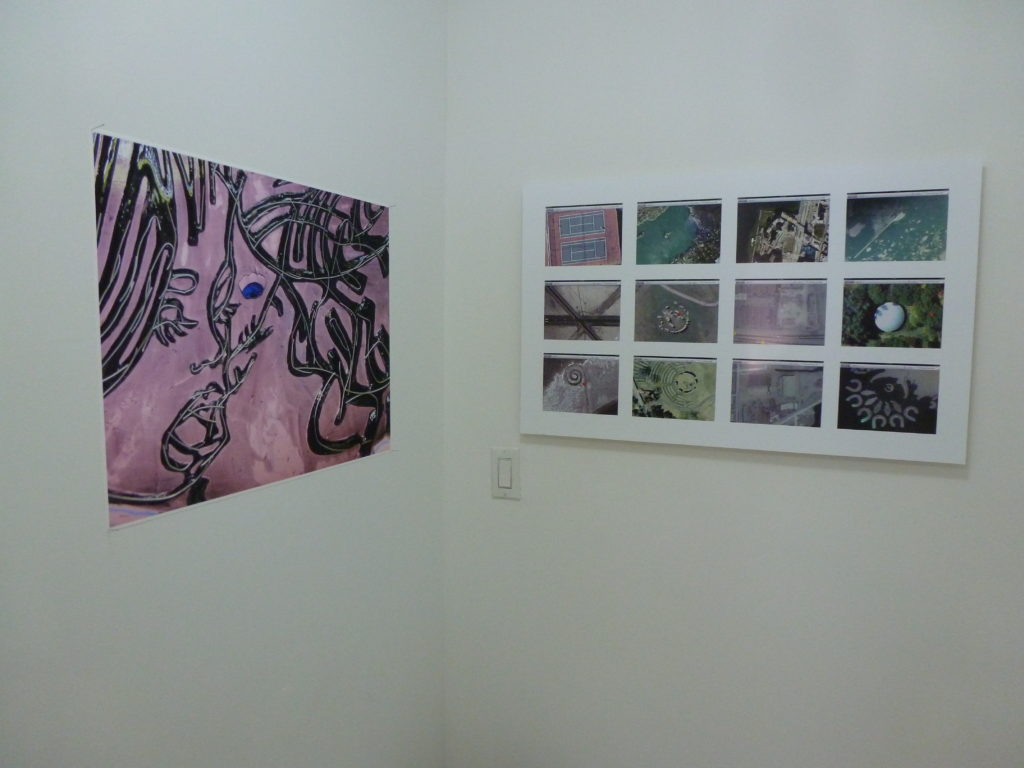
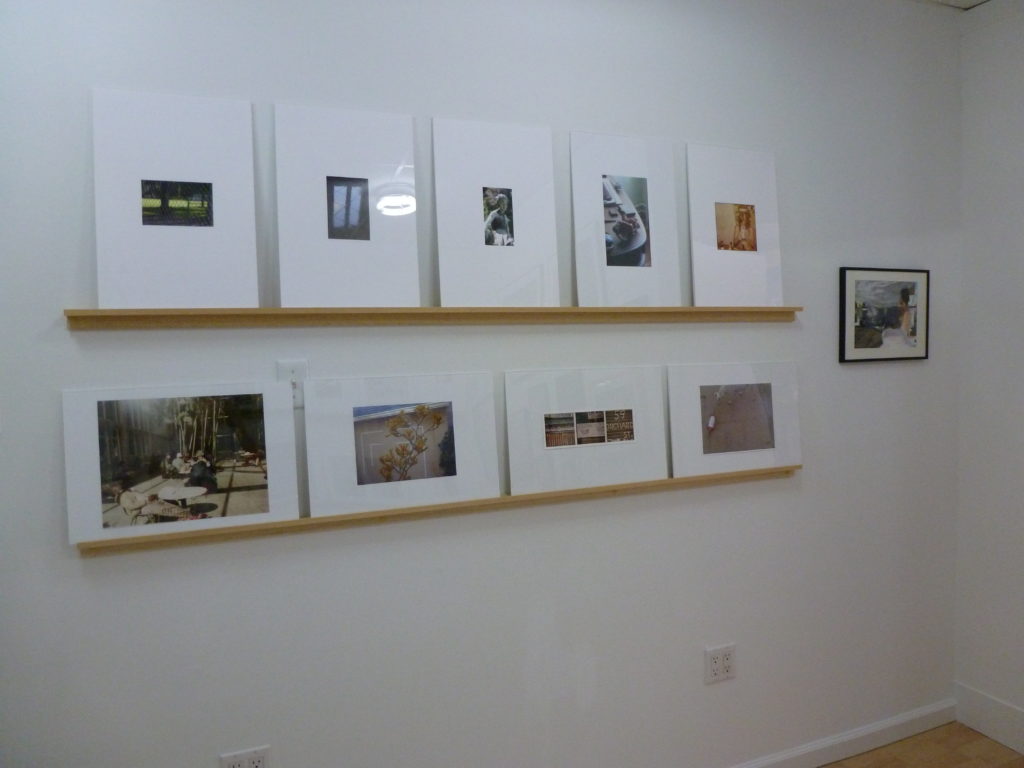
HASEGAWA: ARCHITECTURAL DRAWINGS. February 18th-March 18th, 2012
Japanese architect Itsuko Hasegawa’s architectural drawigs from the Dan Graham collection.
Biography Hasegawa was born in Shizuoka, received her degree in architecture from Kanto Gakuin University (1964), trained with Kiyonori Kikutake. In 1969, Hasegawa entered Kazuo Shinohara’s lab at the Tokyo Institute of Technology as a graduate student. After two years, she became his assistant, a far greater honor and responsibility in Japan than the expression suggests in English. In 1979 she formed her own design firm, Itsuko Hasegawa Atelier, which has designed a number of award-winning buildings in Japan and abroad. Hasegawa is an Honorary Fellow of the Royal Institute of British Architects, and has received the Avon Arts Award, the Building Contractor’s Society Prize for the Shonandai Cultural Center, the Cultural Award for Residential Architecture (Fukuoka, Japan), and a Design Prize from the Architectural Institute of Japan.
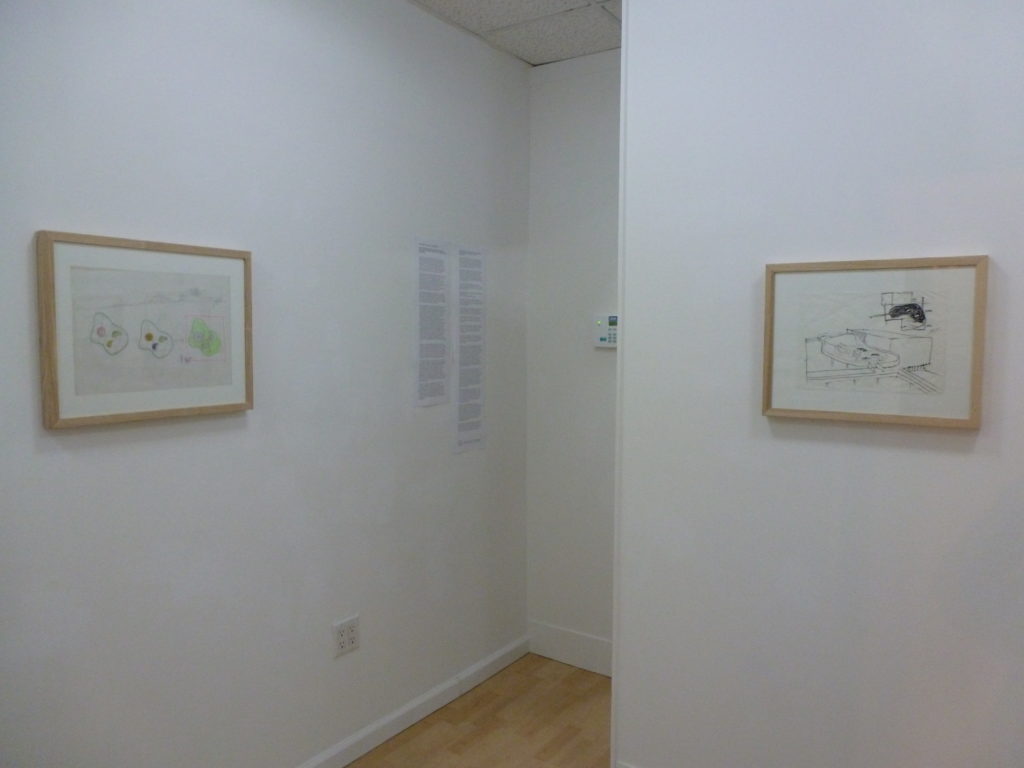




FOOD SHOW. December 18, 2011- January 22, 2012
The food show includes new sculptures by three Japanese/Japanese American artists:
Satoru Eguchi, Mieko Meguro and Trevor Shimizu.
A printed conversation between Asad Raza and Dan Graham, which gives great insight into food and some local restaurants, will also be available to take home.



Dan Graham, Rodney Graham, Mieko Meguro, Raymond Pettibon: ROCK MUSIC SHOW. Sept 25–Oct 30, 2011.










